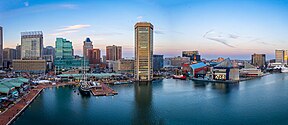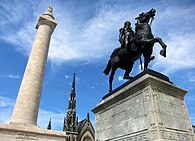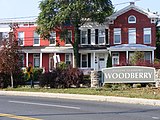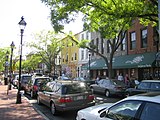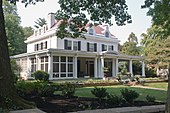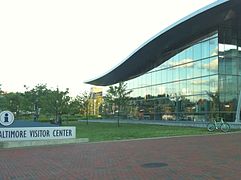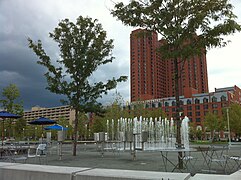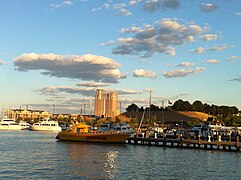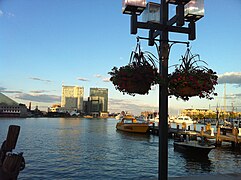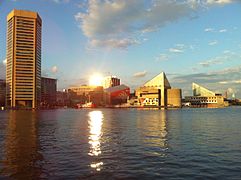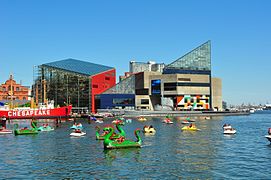Baltimore
Baltimore[a]is themost populous cityin theU.S. stateofMaryland.With a population of 585,708 at the2020 census,it is the30th-most populous cityin the United States.[15]Baltimore was designated anindependent cityby theConstitution of Maryland[b]in 1851, and is currently the most populous independent city in the nation. As of the 2020 census, the population of theBaltimore metropolitan areawas 2,838,327, the20th-largest metropolitan areain the country.[16]When combined with the largerWashington metropolitan area,theWashington–Baltimore combined statistical area(CSA) has a 2020 U.S. census population of 9,973,383, the third-largest in the country.[16]Though the city is not located within or under the administrative jurisdiction of any county in the state, it is considered to be part of the Central Maryland region, together withthe surrounding county that shares its name.
The land that is present-day Baltimore was used as hunting ground byPaleo-Indians.In the early 1600s, theSusquehannockbegan to hunt there.[17]People from theProvince of Marylandestablished thePort of Baltimorein 1706 to support thetobaccotrade with Europe, and established the Town of Baltimore in 1729.
In the mid-18th century, the first printing press and newspapers were introduced to Baltimore byNicholas HasselbachandWilliam Goddard.During theAmerican Revolutionary War,theSecond Continental Congress,fleeingPhiladelphiaprior to thecity's fall to British troops,moved their deliberations toHenry Fite Houseon West Baltimore Street from December 20, 1776, to February 27, 1777, permitting Baltimore to serve briefly asthe nation's capitalbefore the capital returned toIndependence Hallin Philadelphia on March 5, 1777.
TheBattle of Baltimorewas a pivotal engagement during theWar of 1812,culminating in the failedBritishbombardment ofFort McHenry,during whichFrancis Scott Keywrote a poem that would become "The Star-Spangled Banner",which was eventually designated as the American national anthem in 1931.[18]During thePratt Street Riot of 1861,the city was the site of some of the earliest violence associated with theAmerican Civil War.
TheBaltimore and Ohio Railroad,the nation's oldest railroad, was built in 1830 and cemented Baltimore's status as a major transportation hub, giving producers in theMidwestandAppalachiaaccess to the city'sport.Baltimore'sInner Harborwas once the second leadingport of entryforimmigrantsto the United States. In addition, Baltimore was a majormanufacturingcenter.[19]After a decline in major manufacturing,heavy industry,and restructuring of therail industry,Baltimore has shifted to aservice-oriented economy.Johns Hopkins HospitalandJohns Hopkins Universityare the city's top two employers.[20]Baltimore and its surrounding region are home to the headquarters of a number of major organizations and government agencies, including theNAACP,ABET,theNational Federation of the Blind,Catholic Relief Services,theAnnie E. Casey Foundation,World Relief,theCenters for Medicare & Medicaid Services,and theSocial Security Administration.Baltimore is also home to theBaltimore OriolesofMajor League Baseballand theBaltimore Ravensof theNational Football League.
Many of Baltimore's neighborhoods have rich histories. The city is home to some of the earliestNational Register Historic Districtsin the nation, includingFell's Point,Federal Hill,andMount Vernon.These were added to theNational Registerbetween 1969 and 1971, soon after historic preservation legislation was passed. Baltimore has more public statues and monuments per capita than any other city in the country.[21]Nearly one third of the city's buildings (over 65,000) are designated as historic in the National Register, which is more than any other U.S. city.[22][23]Baltimore has 66National Register Historic Districtsand 33 local historic districts.[22]The historical records of the government of Baltimore are located at theBaltimore City Archives.
History
[edit]Pre-settlement
[edit]The Baltimore area had been inhabited byNative Americanssince at least the10th millennium BC,whenPaleo-Indiansfirst settled in the region.[24]One Paleo-Indian site and severalArchaic periodandWoodland periodarchaeological sites have been identified in Baltimore, including four from theLate Woodland period.[24]In December 2021, several Woodland period Native American artifacts were found inHerring Run Parkin northeast Baltimore, dating 5,000 to 9,000 years ago. The finding followed a period of dormancy in Baltimore City archaeological findings which had persisted since the 1980s.[25]During the Late Woodland period, thearchaeological cultureknown as the Potomac Creek complex resided in the area from Baltimore south to theRappahannock Riverin present-dayVirginia.[26]
Etymology
[edit]The city is named afterCecil Calvert, 2nd Baron Baltimore,[27]an English peer, member of theIrish House of Lordsand founding proprietor of theProvince of Maryland.[28][29]The Calverts took the titleBarons BaltimorefromBaltimore Manor,an EnglishPlantation estatethey were granted inCounty Longford,Ireland.[29][30]Baltimore is ananglicizationof theIrishnameBaile an Tí Mhóir,meaning "town of the big house".[29]
17th century
[edit]In the early 1600s, the immediate Baltimore vicinity was sparsely populated, if at all, by Native Americans. The Baltimore County area northward was used as hunting grounds by theSusquehannockliving in the lowerSusquehanna Rivervalley. ThisIroquoian-speaking people"controlled all of the upper tributaries of the Chesapeake" but "refrained from much contact withPowhatanin thePotomac region"and south into Virginia.[31] Pressured by the Susquehannock, thePiscataway tribe,anAlgonquian-speaking people,stayed well south of the Baltimore area and inhabited primarily the north bank of thePotomac Riverin what are nowCharlesand southernPrince George'scounties in the coastal areas south of theFall Line.[32][33][34]
European colonizationof Maryland began in earnest with the arrival of the merchant shipThe Arkcarrying 140 colonists at St. Clement's Island in thePotomac Riveron March 25, 1634.[35]Europeans then began to settle the area further north, in what is nowBaltimore County.[36]Since Maryland was a colony, Baltimore's streets were named to show loyalty to the mother country, e.g. King, Queen, King George and Caroline streets.[37]The originalcounty seat,known today as Old Baltimore, was located onBush Riverwithin the present-dayAberdeen Proving Ground.[38][39][40]The colonists engaged in sporadic warfare with the Susquehannock, whose numbers dwindled primarily from new infectious diseases, such assmallpox,endemic among the Europeans.[36]In 1661 David Jones claimed the area known today asJonestownon the east bank of theJones Fallsstream.[41]
18th century
[edit]
The colonialGeneral Assembly of Marylandcreated thePort of Baltimoreat old Whetstone Point, nowLocust Point,in 1706 for thetobacco trade.The Town of Baltimore, on the west side of the Jones Falls, was founded on August 8, 1729, when the Governor of Maryland signed an act allowing "the building of a Town on the North side of the Patapsco River." Surveyors began laying out the town on January 12, 1730. By 1752 the town had just 27 homes, including a church and two taverns.[37]Jonestown and Fells Point had been settled to the east. The three settlements, covering 60 acres (24 ha), became a commercial hub, and in 1768 were designated as the county seat.[42]
The first printing press was introduced to the city in 1765 byNicholas Hasselbach,whose equipment was later used in the printing of Baltimore's first newspapers,The Maryland JournalandThe Baltimore Advertiser,first published byWilliam Goddardin 1773.[43][44][45]
Baltimore grew swiftly in the 18th century, its plantations producing grain and tobacco forsugar-producing colonies in the Caribbean.The profit from sugar encouraged the cultivation of cane in the Caribbean and the importation of food by planters there.[46]Since Baltimore was the county seat, a courthouse was built in 1768 to serve both the city and county. Its square was a center of community meetings and discussions.
Baltimore established itspublic market systemin 1763.[47]Lexington Market,founded in 1782, is one of the oldest continuously operating public markets in the United States today.[48]Lexington Market was also a center of slave trading. Enslaved Black people were sold at numerous sites through the downtown area, with sales advertised inThe Baltimore Sun.[49]Both tobacco and sugar cane were labor-intensive crops.
In 1774, Baltimore established the first post office system in what became the United States,[50]and the first water company chartered in the newly independent nation, Baltimore Water Company, 1792.[51][52]
Baltimore played a part in theAmerican Revolution.City leaders such asJonathan Plowman Jr.led many residents toresist British taxes,and merchants signed agreements refusing to trade with Britain.[53]TheSecond Continental Congressmet in theHenry Fite Housefrom December 1776 to February 1777, effectively making the city thecapital of the United Statesduring this period.[54]
Baltimore,Jonestown,andFells Pointwereincorporatedas the City of Baltimore in 1796–1797.
19th century
[edit]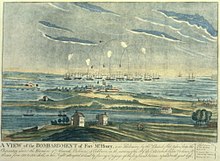
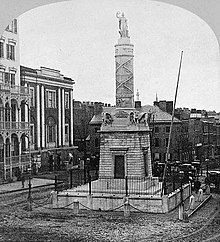
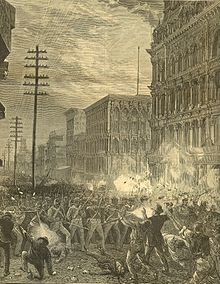
The city remained a part of surroundingBaltimore Countyand continued to serve as its county seat from 1768 to 1851, after which it became anindependent city.[57]
TheBattle of Baltimoreagainst the British in 1814 inspired the U.S. national anthem, "The Star-Spangled Banner",and the construction of theBattle Monument,which became the city's official emblem. A distinctive local culture started to take shape, and a unique skyline peppered with churches and monuments developed. Baltimore acquired its moniker "The Monumental City" after an 1827 visit to Baltimore by PresidentJohn Quincy Adams.At an evening function, Adams gave the following toast: "Baltimore: the Monumental City—May the days of her safety be as prosperous and happy, as the days of her dangers have been trying and triumphant."[58][59]
Baltimore pioneered the use ofgas lightingin 1816, and its population grew rapidly in the following decades, with concomitant development of culture and infrastructure. The construction of the federally fundedNational Road,which later became part ofU.S. Route 40,and the privateBaltimore and Ohio Railroad(B. & O.) made Baltimore a major shipping andmanufacturingcenter by linking the city with major markets in theMidwest.By 1820 its population had reached 60,000, and its economy had shifted from its base in tobacco plantations tosawmilling,shipbuilding,andtextileproduction. These industries benefited from war but successfully shifted intoinfrastructuredevelopment during peacetime.[60]
Baltimore had one of the worst riots of the antebellumSouthin 1835, when bad investments led to theBaltimore bank riot.[61]It was these riots that led to the city beingnicknamed"Mobtown".[62]Soon after the city created the world's first dental college, theBaltimore College of Dental Surgery,in 1840, and shared in theworld's first telegraph line,between Baltimore andWashington, D.C.,in 1844.
Maryland, aslave statewith limited popular support forsecession,especially in the three counties of Southern Maryland, remained part of theUnionduring theAmerican Civil War,following the 55–12 vote by the Maryland General Assembly against secession. Later, the Union's strategic occupation of the city in 1861 ensured Maryland would not further consider secession.[63][64]The Union's capital of Washington, D.C. was well-situated to impede Baltimore and Maryland's communication or commerce with theConfederacy.Baltimore experienced some of the first casualties of Civil War on April 19, 1861, whenUnion Armysoldiers en route fromPresident Street StationtoCamden Yardsclashed with a secessionist mob in thePratt Street riot.
In the midst of theLong Depressionthat followed thePanic of 1873,theBaltimore and Ohio Railroadcompany attempted to lower its workers' wages, leading tostrikes and riotsin the city andbeyond.Strikers clashed with theNational Guard,leaving 10 dead and 25 wounded.[65]The beginnings ofsettlement movementwork in Baltimore were made early in 1893, when Rev. Edward A. Lawrence took up lodgings with his friend Frank Thompson, in one of theWinanstenements, theLawrence Housebeing established shortly thereafter at 814-816 West Lombard Street.[66][67]
20th century
[edit]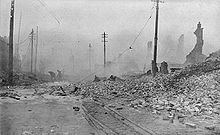
On February 7, 1904, theGreat Baltimore Firedestroyed over 1,500 buildings in 30 hours, leaving more than 70 blocks of the downtown area burned to the ground. Damages were estimated at $150 million in 1904 dollars.[68]As the city rebuilt during the next two years, lessons learned from the fire led to improvements in firefighting equipment standards.[69]
Baltimore lawyer Milton Dashiell advocated for an ordinance to bar African-Americans from moving into theEutaw Placeneighborhood in northwest Baltimore. He proposed to recognize majority white residential blocks and majority black residential blocks and to prevent people from moving into housing on such blocks where they would be a minority. The Baltimore Council passed the ordinance, and it became law on December 20, 1910, with DemocraticMayor J. Barry Mahool's signature.[70]The Baltimore segregation ordinance was the first of its kind in the United States. Many other southern cities followed with their own segregation ordinances, though the US Supreme Court ruled against them inBuchanan v. Warley(1917).[71]
The city grew in area by annexing new suburbs from the surrounding counties through 1918, when the city acquired portions of Baltimore County andAnne Arundel County.[72]A state constitutional amendment, approved in 1948, required a special vote of the citizens in any proposed annexation area, effectively preventing any future expansion of the city's boundaries.[73]Streetcarsenabled the development of distant neighborhoods areas such asEdmonson Villagewhose residents could easily commute to work downtown.[74]
Driven by migration from thedeep Southand bywhite suburbanization,the relative size of the city'sblackpopulation grew from 23.8% in 1950 to 46.4% in 1970.[75]Encouraged by real estateblockbustingtechniques, recently settled white areas rapidly became all-black neighborhoods, in a rapid process which was nearly total by 1970.[76]
TheBaltimore riot of 1968,coinciding withuprisings in other cities,followed theassassination of Martin Luther King Jr.on April 4, 1968. Public order was not restored until April 12, 1968. The Baltimore uprising cost the city an estimated $10 million (US$ 88 million in 2024). A total of 12,000 Maryland National Guard and federal troops were ordered into the city.[77]The city experienced challenges again in 1974 when teachers,municipal workers,andpolice officersconducted strikes.[78]
By the beginning of the 1970s, Baltimore's downtown area, known as the Inner Harbor, had been neglected and was occupied by a collection of abandoned warehouses. The nickname "Charm City" came from a 1975 meeting of advertisers seeking to improve the city's reputation.[79][80]Efforts to redevelop the area started with the construction of theMaryland Science Center,which opened in 1976, theBaltimore World Trade Center(1977), and theBaltimore Convention Center(1979).Harborplace,an urban retail and restaurant complex, opened on the waterfront in 1980, followed by theNational Aquarium,Maryland's largest tourist destination, and theBaltimore Museum of Industryin 1981. In 1995, the city opened theAmerican Visionary Art Museumon Federal Hill. During theepidemic of HIV/AIDS in the United States,Baltimore City Health Departmentofficial Robert Mehl persuaded the city's mayor to form a committee to address food problems. The Baltimore-based charityMoveable Feastgrew out of this initiative in 1990.[81][82][83]
In 1992, theBaltimore Oriolesbaseball teammoved fromMemorial StadiumtoOriole Park at Camden Yards,located downtown near the harbor.Pope John Paul IIheld an open-air mass at Camden Yards during his papal visit to the United States in October 1995. Three years later theBaltimore Ravensfootball teammoved intoM&T Bank Stadiumnext to Camden Yards.[84]
Baltimore has had ahigh homicide ratefor several decades, peaking in 1993, and again in 2015.[85][86]These deaths have taken an especially severe toll within the black community.[87]Following thedeath of Freddie Grayin April 2015, the city experiencedmajor protestsand international media attention, as well as a clash between local youth and police that resulted in astate of emergencydeclaration and a curfew.[88]
21st century
[edit]Baltimore has seen the reopening of theHippodrome Theatrein 2004,[89]the opening of theReginald F. Lewis Museum of Maryland African American History & Culturein 2005, and the establishment of theNational Slavic Museumin 2012. On April 12, 2012, Johns Hopkins held a dedication ceremony to mark the completion of one of the United States' largest medical complexes – the Johns Hopkins Hospital in Baltimore – which features the Sheikh Zayed Cardiovascular and Critical Care Tower and The Charlotte R. Bloomberg Children's Center. The event, held at the entrance to the $1.1 billion 1.6 million-square-foot-facility, honored the many donors includingSheikh Khalifa bin Zayed Al Nahyan,first president of theUnited Arab Emirates,andMichael Bloomberg.[90][91]
In September 2016, the Baltimore City Council approved a $660 million bond deal for the $5.5 billionPort Covingtonredevelopment project championed byUnder ArmourfounderKevin Plankand his real estate company Sagamore Development. Port Covington surpassed the Harbor Point development as the largesttax-increment financingdeal in Baltimore's history and among the largest urban redevelopment projects in the country.[92]The waterfront development that includes the new headquarters for Under Armour, as well as shops, housing, offices, and manufacturing spaces is projected to create 26,500 permanent jobs with a $4.3 billion annual economic impact.[93]Goldman Sachsinvested $233 million into the redevelopment project.[94]

In the early hours of March 26, 2024, the city's 1.6-mile-long (2.6 km)Francis Scott Key Bridge,which constituted a southeast portion of theBaltimore Beltway,was struck by a container ship andcompletely collapsed.A major rescue operation was launched with US authorities attempting to rescue people in the water.[95] Eight construction workers, who were working on the bridge at the time, fell into thePatapsco River.[96]Two people were rescued from the water,[97]and the bodies of the remaining six were all found by May 7.[98]Replacement of the bridgewas estimated in May 2024 at a cost approaching $2 billion for a fall 2028 completion.[99]
Geography
[edit]Baltimore is in north-central Maryland on thePatapsco River,close to where it empties into theChesapeake Bay.The city is located on thefall linebetween thePiedmontPlateau and theAtlantic coastal plain,which divides Baltimore into "lower city" and "upper city". The city's elevation ranges from sea level at the harbor to 480 feet (150 m) in the northwest corner nearPimlico.[6]
According to the 2010 census, the city has a total area of 92.1 square miles (239 km2), of which 80.9 sq mi (210 km2) is land and 11.1 sq mi (29 km2) is water.[100]The total area is 12.1 percent water.
Baltimore is almost surrounded by Baltimore County, but ispolitically independentof it. It is bordered byAnne Arundel Countyto the south.
Cityscape
[edit]Architecture
[edit]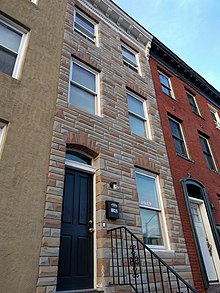
Baltimore exhibits examples from each period of architecture over more than two centuries, and work from architects such asBenjamin Latrobe,George A. Frederick,John Russell Pope,Mies van der Rohe,andI. M. Pei.
Baltimore is rich in architecturally significant buildings in a variety of styles. TheBaltimore Basilica(1806–1821) is a neoclassical design by Benjamin Latrobe, and one of the oldestCatholiccathedrals in the United States. In 1813, Robert Cary Long Sr. built forRembrandt Pealethe first substantial structure in the United States designed expressly as a museum. Restored, it is now the Municipal Museum of Baltimore, or popularly thePeale Museum.
TheMcKim Free Schoolwas founded and endowed by John McKim. The building was erected by his sonIsaacin 1822 after a design by William Howard and William Small. It reflects the popular interest inGreecewhen the nation was securing its independence and a scholarly interest in recently published drawings of Athenian antiquities.
ThePhoenix Shot Tower(1828), at 234.25 feet (71.40 m) tall, was the tallest building in the United States until the time of the Civil War, and is one of few remaining structures of its kind.[101]It was constructed without the use of exterior scaffolding. The Sun Iron Building, designed by R.C. Hatfield in 1851, was the city's first iron-front building and was a model for a whole generation of downtown buildings.Brown Memorial Presbyterian Church,built in 1870 in memory of financierGeorge Brown,hasstained glasswindows byLouis Comfort Tiffanyand has been called "one of the most significant buildings in this city, a treasure of art and architecture" byBaltimoremagazine.[102][103]
The 1845Greek Revival-styleLloyd Street Synagogueis one of theoldest synagogues in the United States.TheJohns Hopkins Hospital,designed byLt. Col. John S. Billingsin 1876, was a considerable achievement for its day in functional arrangement and fireproofing.
I.M. Pei'sWorld Trade Center(1977) is the tallest equilateral pentagonal building in the world at 405 feet (123 m) tall.
TheHarbor Eastarea has seen the addition of two new towers which have completed construction: a 24-floor tower that is the new world headquarters ofLegg Mason,and a 21-floorFour Seasons Hotelcomplex.
The streets of Baltimore are organized in a grid and spoke pattern, lined with tens of thousands ofrowhouses.The mix of materials on the face of these rowhouses also give Baltimore its distinct look. The rowhouses are a mix of brick and formstone facings, the latter a technology patented in 1937 by Albert Knight.John Waterscharacterized formstone as "the polyester of brick" in a 30-minute documentary film,Little Castles: A Formstone Phenomenon.[104]InThe Baltimore Rowhouse,Mary Ellen Hayward andCharles Belfoureconsidered the rowhouse as the architectural form defining Baltimore as "perhaps no other American city".[105]In the mid-1790s, developers began building entire neighborhoods of the British-style rowhouses, which became the dominant house type of the city early in the 19th century.[106]
Oriole Park at Camden Yardsis aMajor League Baseballpark, which opened in 1992 and was built as aretro stylebaseball park. Along with the National Aquarium, Camden Yards have helped revive the Inner Harbor area from what once was an exclusivelyindustrial districtfull of dilapidated warehouses into a bustling commercial district full of bars, restaurants, and retail establishments.
After an international competition, theUniversity of Baltimore School of Lawawarded theGermanfirmBehnisch Architekten1st prize for its design, which was selected for the school's new home. After the building's opening in 2013, the design won additional honors including an ENR National "Best of the Best" Award.[107]
Baltimore's newly rehabilitatedEveryman Theatrewas honored by the Baltimore Heritage at the 2013 Preservation Awards Celebration in 2013. Everyman Theatre will receive an Adaptive Reuse and Compatible Design Award as part of Baltimore Heritage's 2013 historic preservation awards ceremony. Baltimore Heritage is Baltimore's nonprofit historic and architectural preservation organization, which works to preserve and promote Baltimore's historic buildings and neighborhoods.[108]
Tallest buildings
[edit]| Rank | Building | Height | Floors | Built | |
|---|---|---|---|---|---|
| 1 | Transamerica Tower(formerly the Legg Mason Building, originally built as the U.S. Fidelity and Guarantee Co. Building)[109] | 529 feet (161 m) | 40 | 1973 | [110] |
| 2 | Bank of America Building(originally built as Baltimore Trust Building, later Sullivan, Mathieson, Md. Nat. Bank, NationsBank Bldgs.) | 509 feet (155 m) | 37 | 1929 | [111] |
| 3 | 414 Light Street | 500 feet (152 m) | 44 | 2018 | [112] |
| 4 | William Donald Schaefer Tower(originally built as the Merritt S. & L. Tower) | 493 feet (150 m) | 37 | 1992 | [113] |
| 5 | Commerce Place(Alex. Brown & Sons/Deutsche Bank Tower) | 454 feet (138 m) | 31 | 1992 | [114] |
| 6 | Baltimore Marriott Waterfront Hotel | 430 feet (131 m) | 32 | 2001 | [115] |
| 7 | 100 East Pratt Street(originally built as the I.B.M. Building) | 418 feet (127 m) | 28 | 1975/1992 | [116] |
| 8 | Baltimore World Trade Center | 405 feet (123 m) | 28 | 1977 | [117] |
| 9 | Tremont Plaza Hotel | 395 feet (120 m) | 37 | 1967 | [118] |
| 10 | Charles Towers South | 385 feet (117 m) | 30 | 1969 | [119] |
Neighborhoods
[edit]
Baltimore is officially divided into nine geographical regions: North, Northeast, East, Southeast, South, Southwest, West, Northwest, and Central, with each district patrolled by a respectiveBaltimore Police Department.Interstate 83andCharles Streetdown toHanover StreetandRitchie Highwayserve as the east–west dividing line andEastern AvenuetoRoute 40as the north–south dividing line; however,Baltimore Streetis north–south dividing line for theU.S. Postal Service.[120]
Central Baltimore
[edit]Central Baltimore, originally called the Middle District,[121]stretches north of the Inner Harbor up to the edge ofDruid Hill Park.Downtown Baltimore has mainly served as a commercial district with limited residential opportunities; however, between 2000 and 2010, the downtown population grew 130 percent as old commercial properties have been replaced by residential property.[122]Still the city's main commercial area and business district, it includes Baltimore's sports complexes:Oriole Park at Camden Yards,M&T Bank Stadium,and theRoyal Farms Arena;and the shops and attractions in the Inner Harbor:Harborplace,theBaltimore Convention Center,theNational Aquarium,Maryland Science Center,Pier Six Pavilion,andPower Plant Live.[120]
TheUniversity of Maryland, Baltimore,theUniversity of Maryland Medical Center,andLexington Marketare also in the central district, as well as theHippodromeand many nightclubs, bars, restaurants, shopping centers and various other attractions.[120][121]The northern portion of Central Baltimore, between downtown and the Druid Hill Park, is home to many of the city's cultural opportunities.Maryland Institute College of Art,thePeabody Institute(music conservatory),George Peabody Library,Enoch Pratt Free Library– Central Library, theLyric Opera House,theJoseph Meyerhoff Symphony Hall,theWalters Art Museum,theMaryland Center for History and Cultureand itsEnoch PrattMansion, and several galleries are located in this region.[123]
North Baltimore
[edit]
Several historic and notable neighborhoods are in this district:Govans(1755),Roland Park(1891),Guilford(1913),Homeland(1924),Hampden,Woodberry,Old Goucher(the original campus ofGoucher College), andJones Falls.Along theYork Roadcorridor going north are the large neighborhoods ofCharles Village,Waverly,andMount Washington.TheStation North Arts and Entertainment Districtis also located in North Baltimore.[124]
South Baltimore
[edit]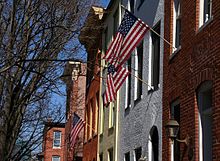
South Baltimore, a mixed industrial and residential area, consists of the "Old South Baltimore" peninsula below the Inner Harbor and east of the oldB&O Railroad's Camden line tracks andRussell Streetdowntown. It is a culturally, ethnically, and socioeconomically diverse waterfront area with neighborhoods such asLocust Pointand Riverside around a large park of the same name.[125]Just south of the Inner Harbor, the historicFederal Hillneighborhood, is home to many working professionals, pubs and restaurants. At the end of the peninsula is historicFort McHenry,a National Park since the end of World War I, when the old U.S. Army Hospital surrounding the 1798 star-shaped battlements was torn down.[126]
Across the Hanover Street Bridge are residential areas such asCherry Hill.[127]
Northeast Baltimore
[edit]Northeast is primarily a residential neighborhood, home toMorgan State University,bounded by the city line of 1919 on its northern and eastern boundaries,Sinclair Lane,Erdman Avenue,andPulaski Highwayto the south andThe Alamedaon to the west. Also in this wedge of the city on33rd StreetisBaltimore City Collegehigh school, third oldest active public secondary school in the United States, founded downtown in 1839.[128]AcrossLoch Raven Boulevardis the former site of the oldMemorial Stadiumhome of theBaltimore Colts,Baltimore Orioles,andBaltimore Ravens,now replaced by aYMCAathletic and housing complex.[129][130]Lake Montebellois in Northeast Baltimore.[121]
East Baltimore
[edit]Located belowSinclair LaneandErdman Avenue,aboveOrleans Street,East Baltimore is mainly made up of residential neighborhoods. This section of East Baltimore is home toJohns Hopkins Hospital,Johns Hopkins University School of Medicine,andJohns Hopkins Children's CenteronBroadway.Notable neighborhoods include:Armistead Gardens,Broadway East,Barclay,Ellwood Park,Greenmount,andMcElderry Park.[121]
This area was the on-site film location forHomicide: Life on the Street,The CornerandThe Wire.[131]
Southeast Baltimore
[edit]Southeast Baltimore, located belowFayette Street,bordering the Inner Harbor and the Northwest Branch of thePatapsco Riverto the west, the city line of 1919 on its eastern boundaries and the Patapsco River to the south, is a mixed industrial and residential area.Patterson Park,the "Best Backyard in Baltimore",[132]as well as theHighlandtown Arts District,andJohns Hopkins Bayview Medical Centerare located in Southeast Baltimore. The Shops at Canton Crossing opened in 2013.[133]TheCantonneighborhood, is located along Baltimore's prime waterfront. Other historic neighborhoods include:Fells Point,Patterson Park,Butchers Hill,Highlandtown,Greektown,Harbor East,Little Italy,andUpper Fell's Point.[121]
Northwest Baltimore
[edit]Northwestern is bounded by the county line to the north and west,Gwynns Falls Parkwayon the south andPimlico Roadon the east, is home toPimlico Race Course,Sinai Hospital,and the headquarters of theNAACP.Its neighborhoods are mostly residential and are dissected byNorthern Parkway.The area has been the center ofBaltimore's Jewish communitysince after World War II. Notable neighborhoods include:Pimlico,Mount Washington,andCheswolde,andPark Heights.[134]
West Baltimore
[edit]West Baltimore is west of downtown and theMartin Luther King Jr. Boulevardand is bounded by Gwynns Falls Parkway,Fremont Avenue,andWest Baltimore Street.TheOld West Baltimore Historic Districtincludes the neighborhoods ofHarlem Park,Sandtown-Winchester,Druid Heights,Madison Park,andUpton.[135][136]Originally a predominantly German neighborhood, by the last half of the 19th century, Old West Baltimore was home to a substantial section of the city's Black population.[135]
It became the largest neighborhood for the city's Black community and its cultural, political, and economic center.[135]Coppin State University,Mondawmin Mall,andEdmondson Villageare located in this district. The area's crime problems have provided subject material for television series, such asThe Wire.[137]Local organizations, such as the Sandtown Habitat for Humanity and the Upton Planning Committee, have been steadily transforming parts of formerly blighted areas of West Baltimore into clean, safe communities.[138][139]
Southwest Baltimore
[edit]Southwest Baltimore is bound by the Baltimore County line to the west, WestBaltimore Streetto the north, andMartin Luther King Jr. BoulevardandRussell Street/Baltimore-Washington Parkway(Maryland Route 295) to the east. Notable neighborhoods in Southwest Baltimore include:Pigtown,Carrollton Ridge,Ridgely's Delight,Leakin Park,Violetville,Lakeland,andMorrell Park.[121]
St. Agnes HospitalonWilkensandCaton[121]avenues is located in this district with the neighboringCardinal Gibbons High School,which is the former site ofBabe Ruth's alma mater, St. Mary's Industrial School.[citation needed]Through this segment of Baltimore ran the beginnings of the historicNational Road,which was constructed beginning in 1806 alongOld Frederick Roadand continuing into the county onFrederick RoadintoEllicott City, Maryland.[citation needed]Other sides in this district are:Carroll Park,one of the city's largest parks, the colonial Mount Clare Mansion, andWashington Boulevard,which dates to pre-Revolutionary War days as the prime route out of the city toAlexandria, Virginia,andGeorgetownon thePotomac River.[citation needed]
Adjacent communities
[edit]Baltimore is bordered by the following communities, all unincorporatedcensus-designated places.
Climate
[edit]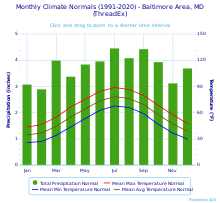
Baltimore has ahumid subtropical climate(Cfa) in theKöppen climate classification,with hot summers, cool winters, and a summer peak to annual precipitation.[140][141]Baltimore is part of USDA planthardiness zones7b and 8a.[142]Summers are normally warm, with occasional late day thunderstorms. July, the warmest month, has a mean temperature of 80.3 °F (26.8 °C). Winters range from chilly to mild but vary, with sporadic snowfall: January has a daily average of 35.8 °F (2.1 °C),[143]though temperatures reach 50 °F (10 °C) quite often, and can occasionally drop below 20 °F (−7 °C) when Arctic air masses affect the area.[143]According toVox,winters are warming faster than summers.[141]
Spring and autumn are mild, with spring being the wettest season in terms of the number of precipitation days. Summers are hot and humid with a daily average in July of 80.7 °F (27.1 °C).[143]The combination of heat and humidity leads to occasional thunderstorms. A southeasterly bay breeze off the Chesapeake often occurs on summer afternoons when hot air rises over inland areas. Prevailing winds from the southwest interacting with this breeze as well as the city proper's UHI can seriously exacerbate air quality.[144][145]In late summer and early autumn the track of hurricanes or their remnants may cause flooding in downtown Baltimore, despite the city being far removed from the typical coastalstorm surgeareas.[146]
The average seasonal snowfall is 19 inches (48 cm).[147]It varies greatly by year, with some seasons seeing only trace accumulations of snow, while others see several majorNor'easters.[c]Owing to lessenedurban heat island(UHI) as compared to thecity properand distance from the moderating Chesapeake Bay, the outlying and inland parts of the Baltimore metro area are usually cooler, especially at night, than the city proper and the coastal towns. Thus, in the northern and western suburbs, winter snowfall is more significant, and some areas average more than 30 in (76 cm) of snow per winter.[149]
It is by not uncommon for the rain-snow line to set up in the metro area.[150]Freezing rainand sleet occur a few times some winters in the area, as warm air overrides cold air at the low to mid-levels of the atmosphere. When the wind blows from the east, the cold air getsdammed against the mountainsto the west and the result is freezing rain or sleet.
Likeall of Maryland,Baltimore is at risk for increased impacts ofclimate change.Historically, flooding has ruined houses and almost killed people, especially in lower income majority Black neighborhoods, and caused sewage backups, given the existing disrepair of Baltimore's water system.[151]
Extreme temperatures range from −7 °F (−22 °C) on February 9, 1934, andFebruary 10, 1899,[d]up to 108 °F (42 °C) on July 22, 2011.[152][153]On average, temperatures of 100 °F (38 °C) or more occur on three days annually, 90 °F (32 °C) or more on 43 days, and there are nine days where the high fails to reach the freezing mark.[143]
| Climate data for Baltimore (Baltimore/Washington International Airport) 1991−2020 normals,[e]extremes 1872–present[f]) | |||||||||||||
|---|---|---|---|---|---|---|---|---|---|---|---|---|---|
| Month | Jan | Feb | Mar | Apr | May | Jun | Jul | Aug | Sep | Oct | Nov | Dec | Year |
| Record high °F (°C) | 79 (26) |
83 (28) |
90 (32) |
94 (34) |
98 (37) |
105 (41) |
107 (42) |
105 (41) |
101 (38) |
98 (37) |
86 (30) |
77 (25) |
107 (42) |
| Mean maximum °F (°C) | 64.6 (18.1) |
66.4 (19.1) |
75.9 (24.4) |
85.8 (29.9) |
91.0 (32.8) |
95.9 (35.5) |
98.0 (36.7) |
95.9 (35.5) |
91.1 (32.8) |
83.8 (28.8) |
74.3 (23.5) |
66.0 (18.9) |
98.9 (37.2) |
| Mean daily maximum °F (°C) | 43.2 (6.2) |
46.4 (8.0) |
54.8 (12.7) |
66.5 (19.2) |
75.5 (24.2) |
84.4 (29.1) |
88.8 (31.6) |
86.5 (30.3) |
79.7 (26.5) |
68.3 (20.2) |
57.3 (14.1) |
47.5 (8.6) |
66.6 (19.2) |
| Daily mean °F (°C) | 34.3 (1.3) |
36.6 (2.6) |
44.3 (6.8) |
55.0 (12.8) |
64.4 (18.0) |
73.5 (23.1) |
78.3 (25.7) |
76.2 (24.6) |
69.2 (20.7) |
57.4 (14.1) |
46.9 (8.3) |
38.6 (3.7) |
56.2 (13.4) |
| Mean daily minimum °F (°C) | 25.4 (−3.7) |
26.9 (−2.8) |
33.9 (1.1) |
43.6 (6.4) |
53.3 (11.8) |
62.6 (17.0) |
67.7 (19.8) |
65.8 (18.8) |
58.8 (14.9) |
46.5 (8.1) |
36.5 (2.5) |
29.6 (−1.3) |
45.9 (7.7) |
| Mean minimum °F (°C) | 9.1 (−12.7) |
12.2 (−11.0) |
18.9 (−7.3) |
29.7 (−1.3) |
38.8 (3.8) |
49.3 (9.6) |
57.9 (14.4) |
55.8 (13.2) |
45.1 (7.3) |
32.8 (0.4) |
22.9 (−5.1) |
15.6 (−9.1) |
6.9 (−13.9) |
| Record low °F (°C) | −7 (−22) |
−7 (−22) |
4 (−16) |
15 (−9) |
32 (0) |
40 (4) |
50 (10) |
45 (7) |
35 (2) |
25 (−4) |
12 (−11) |
−3 (−19) |
−7 (−22) |
| Averageprecipitationinches (mm) | 3.08 (78) |
2.90 (74) |
4.01 (102) |
3.39 (86) |
3.85 (98) |
3.98 (101) |
4.48 (114) |
4.09 (104) |
4.44 (113) |
3.94 (100) |
3.13 (80) |
3.71 (94) |
45.00 (1,143) |
| Average snowfall inches (cm) | 6.4 (16) |
7.5 (19) |
2.8 (7.1) |
0.0 (0.0) |
0.0 (0.0) |
0.0 (0.0) |
0.0 (0.0) |
0.0 (0.0) |
0.0 (0.0) |
0.0 (0.0) |
0.1 (0.25) |
2.5 (6.4) |
19.3 (49) |
| Average precipitation days(≥ 0.01 in) | 10.1 | 9.3 | 11.0 | 11.2 | 11.9 | 11.3 | 10.4 | 9.6 | 9.1 | 8.6 | 8.5 | 10.3 | 121.3 |
| Average snowy days(≥ 0.1 in) | 2.8 | 2.9 | 1.5 | 0.1 | 0.0 | 0.0 | 0.0 | 0.0 | 0.0 | 0.0 | 0.2 | 1.5 | 9.0 |
| Averagerelative humidity(%) | 63.2 | 61.3 | 59.2 | 58.9 | 66.1 | 68.4 | 69.1 | 71.1 | 71.3 | 69.5 | 66.5 | 65.5 | 65.8 |
| Averagedew point°F (°C) | 19.9 (−6.7) |
21.6 (−5.8) |
28.9 (−1.7) |
37.6 (3.1) |
50.4 (10.2) |
60.1 (15.6) |
64.6 (18.1) |
64.0 (17.8) |
57.6 (14.2) |
45.5 (7.5) |
35.2 (1.8) |
25.3 (−3.7) |
42.6 (5.9) |
| Mean monthlysunshine hours | 155.4 | 164.0 | 215.0 | 230.7 | 254.5 | 277.3 | 290.1 | 264.4 | 221.8 | 205.5 | 158.5 | 144.5 | 2,581.7 |
| Percentpossible sunshine | 51 | 54 | 58 | 58 | 57 | 62 | 64 | 62 | 59 | 59 | 52 | 49 | 58 |
| Source:NOAA(relative humidity, dew points and sun 1961–1990)[147][154][155] | |||||||||||||
| Climate data for Baltimore (Maryland Science Center) 1991−2020 normals, extremes 1950–present | |||||||||||||
|---|---|---|---|---|---|---|---|---|---|---|---|---|---|
| Month | Jan | Feb | Mar | Apr | May | Jun | Jul | Aug | Sep | Oct | Nov | Dec | Year |
| Record high °F (°C) | 77 (25) |
84 (29) |
97 (36) |
98 (37) |
100 (38) |
106 (41) |
108 (42) |
106 (41) |
102 (39) |
95 (35) |
87 (31) |
85 (29) |
108 (42) |
| Mean maximum °F (°C) | 65.0 (18.3) |
66.5 (19.2) |
77.0 (25.0) |
87.7 (30.9) |
92.5 (33.6) |
97.3 (36.3) |
99.7 (37.6) |
97.8 (36.6) |
92.9 (33.8) |
85.4 (29.7) |
75.4 (24.1) |
67.1 (19.5) |
100.9 (38.3) |
| Mean daily maximum °F (°C) | 43.7 (6.5) |
46.8 (8.2) |
55.2 (12.9) |
66.8 (19.3) |
75.9 (24.4) |
85.4 (29.7) |
90.1 (32.3) |
87.3 (30.7) |
80.4 (26.9) |
68.8 (20.4) |
57.6 (14.2) |
48.0 (8.9) |
67.2 (19.6) |
| Daily mean °F (°C) | 36.9 (2.7) |
39.4 (4.1) |
46.9 (8.3) |
57.5 (14.2) |
67.0 (19.4) |
76.6 (24.8) |
81.5 (27.5) |
79.1 (26.2) |
72.5 (22.5) |
60.7 (15.9) |
50.1 (10.1) |
41.3 (5.2) |
59.1 (15.1) |
| Mean daily minimum °F (°C) | 30.0 (−1.1) |
31.9 (−0.1) |
38.7 (3.7) |
48.2 (9.0) |
58.0 (14.4) |
67.7 (19.8) |
72.9 (22.7) |
71.0 (21.7) |
64.5 (18.1) |
52.6 (11.4) |
42.6 (5.9) |
34.6 (1.4) |
51.1 (10.6) |
| Mean minimum °F (°C) | 14.7 (−9.6) |
17.3 (−8.2) |
23.9 (−4.5) |
36.2 (2.3) |
46.9 (8.3) |
57.5 (14.2) |
65.6 (18.7) |
63.2 (17.3) |
53.4 (11.9) |
40.3 (4.6) |
29.9 (−1.2) |
22.2 (−5.4) |
12.5 (−10.8) |
| Record low °F (°C) | −4 (−20) |
−3 (−19) |
12 (−11) |
21 (−6) |
36 (2) |
48 (9) |
58 (14) |
52 (11) |
40 (4) |
30 (−1) |
16 (−9) |
6 (−14) |
−4 (−20) |
| Averageprecipitationinches (mm) | 3.07 (78) |
2.75 (70) |
3.93 (100) |
3.55 (90) |
3.39 (86) |
3.36 (85) |
4.71 (120) |
4.35 (110) |
4.49 (114) |
3.49 (89) |
2.98 (76) |
3.66 (93) |
43.73 (1,111) |
| Average precipitation days(≥ 0.01 in) | 9.9 | 9.7 | 10.7 | 11.0 | 11.3 | 10.7 | 10.6 | 9.5 | 8.5 | 8.5 | 8.1 | 10.2 | 118.7 |
| Source:NOAA[143][147] | |||||||||||||
| Climate data for Baltimore | |||||||||||||
|---|---|---|---|---|---|---|---|---|---|---|---|---|---|
| Month | Jan | Feb | Mar | Apr | May | Jun | Jul | Aug | Sep | Oct | Nov | Dec | Year |
| Average sea temperature °F (°C) | 46.0 (7.8) |
44.4 (6.9) |
45.1 (7.3) |
50.4 (10.2) |
55.9 (13.3) |
68.2 (20.1) |
75.6 (24.2) |
77.4 (25.2) |
73.4 (23.0) |
66.0 (18.9) |
57.2 (14.0) |
50.7 (10.4) |
59.2 (15.1) |
| Mean daily daylight hours | 10.0 | 11.0 | 12.0 | 13.0 | 14.0 | 15.0 | 15.0 | 14.0 | 12.0 | 11.0 | 10.0 | 9.0 | 12.2 |
| Source: Weather Atlas[156] | |||||||||||||
Graphs are unavailable due to technical issues. There is more info onPhabricatorand onMediaWiki.org. |
See or editraw graph data.
Demographics
[edit]Population
[edit]| Year | Pop. | ±% |
|---|---|---|
| 1752 | 200 | — |
| 1775 | 5,934 | +2867.0% |
| 1790 | 13,503 | +127.6% |
| 1800 | 26,514 | +96.4% |
| 1810 | 46,555 | +75.6% |
| 1820 | 62,738 | +34.8% |
| 1830 | 80,620 | +28.5% |
| 1840 | 102,313 | +26.9% |
| 1850 | 169,054 | +65.2% |
| 1860 | 212,418 | +25.7% |
| 1870 | 267,354 | +25.9% |
| 1880 | 332,313 | +24.3% |
| 1890 | 434,439 | +30.7% |
| 1900 | 508,957 | +17.2% |
| 1910 | 558,485 | +9.7% |
| 1920 | 733,826 | +31.4% |
| 1930 | 804,874 | +9.7% |
| 1940 | 859,100 | +6.7% |
| 1950 | 949,708 | +10.5% |
| 1960 | 939,024 | −1.1% |
| 1970 | 905,787 | −3.5% |
| 1980 | 786,741 | −13.1% |
| 1990 | 736,016 | −6.4% |
| 2000 | 651,154 | −11.5% |
| 2010 | 620,961 | −4.6% |
| 2020 | 585,708 | −5.7% |
| U.S. Decennial Census[157] 1790–1960[158]1900–1990[159] 1990–2000[160]2010–2020[15] 1752 estimate & 1775 census[161] | ||
Baltimore reached a peak population of 949,708 at the 1950 U.S. census count. In every ten-year census count since then, the city has lost population, with its 2020 census population at 585,708. In 2011, then-MayorStephanie Rawlings-Blakesaid one of her goals was to increase the city's population, by improving city services to reduce the number of people leaving the city, and by passing legislation protecting immigrants' rights to stimulate growth.[163]Baltimore is identified as asanctuary city.[164]In 2019, then-MayorJack Youngsaid that Baltimore will not assistICEagents with immigration raids.[165]
Baltimore City's population declined from 620,961 in 2010 to 585,708 in 2020, representing a 5.7% drop. In 2020, Baltimore lost more population than any other major city in theUnited States.[166][7][167]
Gentrificationhas increased since the 2000 census, primarily in East Baltimore, downtown, and Central Baltimore, with 14.8% of census tracts having had income growth and home values appreciation at a rate higher than the city overall. Many, but not all, gentrifying neighborhoods are predominantly white areas which have seen a turnover from lower income to higher income households. These areas represent either expansion of existing gentrified areas, or activity around the Inner Harbor, downtown, or the Johns Hopkins Homewood campus.[168]In some neighborhoods in East Baltimore, the Hispanic population has increased, while both the non-Hispanic white and non-Hispanic black populations have declined.[169]
AfterNew York City,Baltimore was the second city in the United States to reach a population of 100,000.[170][171]From the 1820 to 1850 U.S. censuses, Baltimore was the second most-populous city,[171][172]before being surpassed byPhiladelphiaand the then-independentBrooklynin 1860, and then being surpassed bySt. LouisandChicagoin 1870.[173]Baltimore was among the top 10 cities in population in the United States in every census up to the 1980 census.[174]After World War II, Baltimore had a population approaching 1 million, until the population began to fall after the 1950 census.
Characteristics
[edit]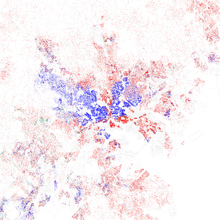
| Historical racial and ethnic profile | 2020[175] | 2010[176] | 1990[177] | 1970[177] | 1940[177] |
|---|---|---|---|---|---|
| White | 31.9% | 29.6% | 39.1% | 53.0% | 80.6% |
| —Non-Hispanic whites | 27.6% | 28.0% | 38.6% | 52.3%[g] | 80.6% |
| Black or African American(non-Hispanic) | 62.4% | 63.7% | 59.2% | 46.4% | 19.3% |
| Hispanic or Latino(of any race) | 6.0% | 4.2% | 1.0% | 0.9%[g] | 0.1% |
| Asian | 2.8% | 2.3% | 1.1% | 0.3% | 0.1% |
| Race / Ethnicity(NH = Non-Hispanic) | Pop 2000[178] | Pop 2010[179] | Pop 2020[180] | % 2000 | % 2010 | % 2020 |
|---|---|---|---|---|---|---|
| Whitealone (NH) | 201,566 | 174,120 | 157,296 | 30.96% | 28.04% | 26.86% |
| Black or African Americanalone (NH) | 417,009 | 392,938 | 335,615 | 64.04% | 63.28% | 57.30% |
| Native AmericanorAlaska Nativealone (NH) | 1,946 | 1,884 | 1,278 | 0.30% | 0.30% | 0.22% |
| Asianalone (NH) | 9,824 | 14,397 | 21,020 | 1.51% | 2.32% | 3.59% |
| Pacific Islanderalone (NH) | 193 | 192 | 152 | 0.03% | 0.03% | 0.03% |
| Some Other Racealone (NH) | 1,143 | 942 | 3,332 | 0.18% | 0.15% | 0.57% |
| Mixed Race or Multi-Racial(NH) | 8,412 | 10,528 | 21,088 | 1.29% | 1.70% | 3.60% |
| Hispanic or Latino(any race) | 11,061 | 25,960 | 45,927 | 1.70% | 4.18% | 7.84% |
| Total | 651,154 | 620,961 | 585,708 | 100.00% | 100.00% | 100.00% |
In the 2010 census[update],Baltimore's population was 63.7%Black,29.6%White(6.9%German,5.8%Italian,4%Irish,2%American,2%Polish,0.5%Greek) 2.3%Asian(0.54%Korean,0.46%Indian,0.37%Chinese,0.36%Filipino,0.21%Nepali,0.16%Pakistani), and 0.4%Native American and Alaska Native.Across races, 4.2% of the population are ofHispanic, Latino, or Spanish origin(1.63%Salvadoran,1.21%Mexican,0.63%Puerto Rican,0.6%Honduran).[15]
As per the 2020 census, 8.1% of residents between 2016 and 2020 were foreign born persons.[175]Females made up 53.4% of the population. The median age was 35 years old, with 22.4% under 18 years old, 65.8% from 18 to 64 years old, and 11.8% 65 or older.[15]
Baltimore has a largeCaribbean Americanpopulation, with the largest groups beingJamaicansandTrinidadians.Baltimore's Jamaican community is largely centered in thePark Heightsneighborhood, but generations of immigrants have also lived in Southeast Baltimore.[181]
In 2005, approximately 30,778 people (6.5%) identified asgay, lesbian, or bisexual.[182]In 2012,same-sex marriage in Marylandwas legalized, going into effect January 1, 2013.[183]
Income and housing
[edit]Between 2016 and 2020, the median household income was $52,164 and the median income per capita was $32,699, compared to the national averages of $64,994 and $35,384, respectively.[175]In 2009, the median household income was $42,241 and the median income per capita was $25,707, compared to the national median income of $53,889 per household and $28,930 per capita.[15]
In 2009, 23.7% of the population lived below the poverty line, compared to 13.5% nationwide.[15]In the 2020 census, 20% of Baltimore residents were living in poverty, compared to 11.6% nationwide.[175]
Housing in Baltimore is relatively inexpensive for large, near-coastal cities of its size. The median sale price for homes in Baltimore as of December 2022 was $209,000, up from $95,000 in 2012.[184][185]Despite the late 2000s housing price collapse, and along with the national trends, Baltimore residents still faced slowly increasing rent, up 3% in the summer of 2010.[186]The median value of owner-occupied housing units between 2016 and 2020 was $242,499.[175]
Thehomelesspopulation in Baltimore is steadily increasing. It exceeded 4,000 people in 2011. The increase in the number of young homeless people was particularly severe.[187]
Life expectancy
[edit]In 2015, life expectancy in Baltimore was 74 to 75 years, compared to the U.S. average of 78 to 80. Fourteen neighborhoods had lower life expectancies thanNorth Korea.The life expectancy in Downtown/Seton Hill was comparable to that ofYemen.[188]
Religion
[edit]
In 2015, 25% of adults in Baltimore reported affiliation with no religion. 50% of the adult population of Baltimore areProtestants.[h]Catholicismis the second-largest religious affiliation, constituting 15% percent of the population, followed byJudaism(3%) andIslam(2%). Around 1% identify with otherChristian denominations.[189][190][191]
Languages
[edit]In 2010, 91% (526,705) of Baltimore residents five years old and older spoke only English at home. Close to 4% (21,661) spoke Spanish. Other languages, such asAfrican languages,French, and Chinese are spoken by less than 1% of the population.[192]
Economy
[edit]Once a predominantly industrial town, with an economic base focused on steel processing, shipping, auto manufacturing (General MotorsBaltimore Assembly), and transportation, Baltimore experienceddeindustrialization,which cost residents tens of thousands of low-skill, high-wage jobs.[193]Baltimore now relies on a low-wageservice economy,which accounts for 31% of jobs in the city.[194][195]Around the turn of the 20th century, Baltimore was the leading U.S. manufacturer ofrye whiskeyandstraw hats.It led in the refining of crude oil, brought to the city by pipeline from Pennsylvania.[196][197][198]
In March 2018, Baltimore's unemployment rate was 5.8%.[199]In 2012, one quarter of Baltimore residents, and 37% of Baltimore children, lived in poverty.[200]The 2012 closure of a major steel plant at Sparrows Point is expected to have a further impact on employment and the local economy.[201]In 2013, 207,000 workers commuted into Baltimore city each day.[202]Downtown Baltimoreis the primary economic asset within Baltimore City and the region, with 29.1 million square feet of office space. The tech sector is rapidly growing as the Baltimore metro ranks 8th in the CBRE Tech Talent Report among 50 U.S. metro areas for high growth rate and number of tech professionals.[203]In 2013,Forbesranked Baltimore fourth among America's "new tech hot spots".[204]
The city is home to theJohns Hopkins Hospital.Other largecompanies in BaltimoreincludeUnder Armour,[205]BRT Laboratories,Cordish Company,[206]Legg Mason,McCormick & Company,T. Rowe Price,andRoyal Farms.[207]Asugar refineryowned byAmerican Sugar Refiningis one of Baltimore's cultural icons. Nonprofits based in Baltimore includeLutheran Services in AmericaandCatholic Relief Services.
Almost a quarter of the jobs in the Baltimore region were in science, technology, engineering, and mathematics as of mid-2013, a fact attributed in part to the city's extensive undergraduate and graduate schools; maintenance and repair experts were included in this count.[208]
Port
[edit]This section needs to beupdated.(March 2024) |
The center of international commerce for the region is theWorld Trade Center Baltimore.It houses the Maryland Port Administration and U.S. headquarters for major shipping lines. Baltimore is ranked 9th for total dollar value of cargo and 13th for cargo tonnage for all U.S. ports. In 2014, total cargo moving through the port totaled 29.5 million tons, down from 30.3 million tons in 2013. The value of cargo traveling through the port in 2014 came to $52.5 billion, down from $52.6 billion in 2013. ThePort of Baltimoregenerates $3 billion in annual wages and salary, as well as supporting 14,630 direct jobs and 108,000 jobs connected to port work. In 2014, the port generated more than $300 million in taxes.[209]
The port serves over 50 ocean carriers, making nearly 1,800 annual visits. Among all U.S. ports, Baltimore is first in handling automobiles, light trucks, farm and construction machinery; and imported forest products, aluminum, and sugar. The port is second in coal exports. The Port of Baltimore's cruise industry, which offers year-round trips on several lines, supports over 500 jobs and brings in over $90 million to Maryland's economy annually. Growth at the port continues with the Maryland Port Administration plans to turn the southern tip of the former steel mill into a marine terminal, primarily for car and truck shipments, and for anticipated new business coming to Baltimore after the completion of thePanama Canal expansion project.[209]
Tourism
[edit]Baltimore's history and attractions have made it a popular tourist destination. In 2014, the city hosted 24.5 million visitors, who spent $5.2 billion.[210]The Baltimore Visitor Center, which is operated byVisit Baltimore,is located on Light Street in the Inner Harbor. Much of the city's tourism centers around the Inner Harbor, with theNational Aquariumbeing Maryland's top tourist destination. Baltimore Harbor's restoration has made it "a city of boats", with several historic ships and other attractions on display and open to the public. TheUSSConstellation,the last Civil War-era vessel afloat, is docked at the head of the Inner Harbor; theUSSTorsk,a submarine that holds the Navy's record for dives (more than 10,000); and the Coast Guard cutterWHEC-37,the last surviving U.S. warship that was inPearl Harborduring theJapanese attackon December 7, 1941, and which engaged Japanese Zero aircraft during the battle.[211]
Also docked is thelightshipChesapeake,which for decades marked the entrance to Chesapeake Bay; and the Seven Foot Knoll Lighthouse, the oldest survivingscrew-pile lighthouseon Chesapeake Bay, which once marked the mouth of the Patapsco River and the entrance to Baltimore. All of these attractions are owned and maintained by theHistoric Ships in Baltimoreorganization. The Inner Harbor is also the home port ofPride of Baltimore II,the state of Maryland's "goodwill ambassador" ship, a reconstruction of a famousBaltimore Clippership.[211]
Other tourist destinations include sporting venues such asOriole Park at Camden Yards,M&T Bank Stadium,andPimlico Race Course,Fort McHenry,theMount Vernon,Federal Hill,andFells Pointneighborhoods,Lexington Market,Horseshoe Casino,and museums such as theWalters Art Museum,theBaltimore Museum of Industry,theBabe Ruth Birthplace and Museum,theMaryland Science Center,and theB&O Railroad Museum.
-
The Baltimore Visitor Center at theInner Harbor
-
Fountain near visitor center in Inner Harbor
-
Sunset views from Inner Harbor
-
Baltimore is the home of theNational Aquarium,one of the world's largest aquariums.
Culture
[edit]
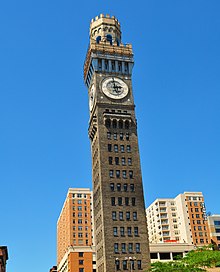
Baltimore has historically been a working-class port town, sometimes dubbed a "city of neighborhoods". It comprises 72 designated historic districts[212]traditionally occupied by distinct ethnic groups. Most notable today are three downtown areas along the port: the Inner Harbor, frequented by tourists because of its hotels, shops, and museums; Fells Point, once a favorite entertainment spot for sailors but now refurbished and gentrified (and featured in the movieSleepless in Seattle); andLittle Italy,located between the other two, where Baltimore's Italian-American community is based – and where U.S. House SpeakerNancy Pelosigrew up.
Further inland,Mount Vernonis the traditional center of cultural and artistic life of the city. It is home to a distinctiveWashington Monument,set atop a hill in a 19th-century urban square, that predates the monument in Washington, D.C. by several decades. Baltimore has a significantGerman Americanpopulation,[213]and was the second-largest port of immigration to the United States behindEllis Islandin New York and New Jersey. Between 1820 and 1989, almost 2 million who were German,Polish,English, Irish,Russian,Lithuanian,French,Ukrainian,Czech,GreekandItaliancame to Baltimore, mostly between 1861 and 1930. By 1913, when Baltimore was averaging forty thousand immigrants per year, World War I closed off the flow of immigrants. By 1970, Baltimore's heyday as an immigration center was a distant memory. There was aChinatowndating back to at least the 1880s, which consisted of 400 Chinese residents. A local Chinese-American association remains based there, with one Chinese restaurant as of 2009.
Beer making thrived in Baltimore from the 1800s to the 1950s, with over 100 old breweries in the city's past.[214]The best remaining example of that history is the oldAmerican Brewery Buildingon North Gay Street and theNational Brewing Companybuilding in theBrewer's Hillneighborhood. In the 1940s the National Brewing Company introduced the nation's first six-pack. National's two most prominent brands, wereNational BohemianBeer colloquially "Natty Boh" andColt 45.Listed on thePabstwebsite as a "Fun Fact", Colt 45 was named after running back#45 Jerry Hillof the 1963Baltimore Coltsand not the.45 caliber handgun ammunition round.Both brands are still made today, albeit outside of Maryland, and served all around the Baltimore area at bars, as well asOriolesandRavensgames.[215]The Natty Boh logo appears on all cans, bottles, and packaging. Merchandise featuring him can be found in shops in Maryland, including several inFells Point.
Each year theArtscapetakes place in the city in theBolton Hillneighborhood, close to the Maryland Institute College of Art. Artscape styles itself as the "largest free arts festival in America".[citation needed]Each May, theMaryland Film Festivaltakes place in Baltimore, using all five screens of the historicCharles Theatreas its anchor venue. Many movies and television shows have been filmed in Baltimore.Homicide: Life on the Streetwas set and filmed in Baltimore, as well asThe Wire.House of CardsandVeepare set in Washington, D.C. but filmed in Baltimore.[216]
Baltimore has cultural museums in many areas of study.The Baltimore Museum of Artand theWalters Art Museumare internationally renowned for their collections of art. The Baltimore Museum of Art has the largest holding of works byHenri Matissein the world.[217]TheAmerican Visionary Art Museumhas been designated byCongressas America's national museum forvisionary art.[218]TheNational Great Blacks In Wax Museumis the first African American wax museum in the country, featuring more than 150 life-size and lifelike wax figures.[51]
Cuisine
[edit]Baltimore is known for its Marylandblue crabs,crab cake,Old Bay Seasoning,pit beef, and the "chicken box". The city has many restaurants in or around the Inner Harbor. The most known and acclaimed are the Charleston, Woodberry Kitchen, and theCharm City Cakesbakery featured on the Food Network'sAce of Cakes.TheLittle Italyneighborhood's biggest draw is the food. Fells Point also is a foodie neighborhood for tourists and locals and is where the oldest continuously running tavern in the country, "The Horse You Came in on Saloon", is located.[219]
Many of Baltimore's upscale restaurants are found in Harbor East. Five public markets are located across Baltimore. TheBaltimore Public Market Systemis the oldest continuously operating public market system in the United States.[220]Lexington Marketis one of the longest-running markets in the world and the longest running in the country, having been around since 1782. The market continues to stand at its original site. Baltimore is the last place in America where one can still findarabbers,vendors who sell fresh fruits and vegetables from a horse-drawn cart that goes up and down neighborhood streets.[221]Food- and drink-rating siteZagatranked Baltimore second in a list of the 17 best food cities in the US in 2015.[222]
Local dialect
[edit]Baltimore city, along with its surrounding regions, is home to a unique local dialect known as theBaltimore dialect.It is part of the largerMid-Atlantic American Englishgroup and is noted to be very similar to thePhiladelphia dialect.[223][224]
The so-called "Bawlmerese" accent is known for its characteristic pronunciation of its long "o" vowel, in which an "eh" sound is added before the long "o" sound (/oʊ/ shifts to [ɘʊ], or even [eʊ]).[225]It adopts Philadelphia's pattern of the short "a" sound, such that the tensed vowel in words like "bath" or "ask" does not match the more relaxed one in "sad" or "act".[223]
Baltimore nativeJohn Watersparodies the city and its dialect extensively in his films. Most arefilmed in Baltimore,including the 1972 cult classicPink Flamingos,as well asHairsprayand itsBroadway musical remake.
Performing arts
[edit]
Baltimore has four state-designated arts and entertainment districts: The Pennsylvania Avenue Black Arts and Entertainment District,Station North Arts and Entertainment District,Highlandtown Arts District,and the Bromo Arts & Entertainment District.[226][227][228]
The Baltimore Office of Promotion and The Arts, a non-profit organization, produces events and arts programs as well as managing several facilities. It is the official Baltimore City Arts Council. BOPA coordinates Baltimore's major events, including New Year's Eve and July 4 celebrations at the Inner Harbor,Artscape,which is America's largest free arts festival, Baltimore Book Festival, Baltimore Farmers' Market & Bazaar, School 33 Art Center's Open Studio Tour, and the Dr. Martin Luther King Jr. Parade.[229]
TheBaltimore Symphony Orchestrais an internationally renowned orchestra, founded in 1916 as a publicly funded municipal organization. Its most recent music director wasMarin Alsop,a protégé ofLeonard Bernstein's.Centerstageis the premier theater company in the city and a regionally well-respected group. TheLyric Opera Houseis the home ofLyric Opera Baltimore,which operates there as part of the Patricia and Arthur Modell Performing Arts Center. Shriver Hall Concert Series, founded in 1966, presents classical chamber music and recitals featuring nationally and internationally recognized artists.[230]
The Baltimore Consorthas been a leading early music ensemble for over twenty-five years. The France-Merrick Performing Arts Center, home of the restoredThomas W. Lamb-designedHippodrome Theatre,has afforded Baltimore the opportunity to become a major regional player in the area of touring Broadway and other performing arts presentations. Renovating Baltimore's historic theatres has become widespread throughout the city. Renovated theatres include theEveryman,Centre,Senator,and most recentlyParkwayTheatre. Other buildings have been reused. These include the formerMercantile Deposit and TrustCompany bank building, which is nowThe Chesapeake Shakespeare CompanyTheater.
Baltimore has a wide array of professional (non-touring) and community theater groups. Aside from Center Stage, resident troupes in the city include The Vagabond Players, the oldest continuously operating community theater group in the country,Everyman Theatre,Single Carrot Theatre,and Baltimore Theatre Festival. Community theaters in the city include Fells Point Community Theatre and theArena Players Inc.,which is the nation's oldest continuously operating African American community theater.[231]In 2009, theBaltimore Rock Opera Society,an all-volunteer theatrical company, launched its first production.[232]
Baltimore is home to thePride of Baltimore Chorus,a three-time international silver medalist women's chorus, affiliated withSweet Adelines International.TheMaryland State Boychoiris located in the northeastern Baltimore neighborhood of Mayfield.
Baltimore is the home of non-profitchamber musicorganization Vivre Musicale. VM won a 2011–2012 award for Adventurous Programming from theAmerican Society of Composers, Authors and PublishersandChamber Music America.[233]
ThePeabody Institute,located in the Mount Vernon neighborhood, is the oldest conservatory of music in the United States.[234]Established in 1857, it is one of the most prestigious in the world,[234]along withJuilliard,Eastman,and theCurtis Institute.TheMorgan State UniversityChoir is also one of the nation's most prestigious university choral ensembles.[235]The city is home to theBaltimore School for the Arts,a public high school in the Mount Vernon neighborhood of Baltimore. The institution is nationally recognized for its success in preparation for students entering music (vocal/instrumental), theatre (acting/theater production), dance, and visual arts.
In 1981, Baltimore hosted the first International Theater Festival, the first such festival in the country. Executive producer Al Kraizer staged 66 performances of nine shows by internationaltheatre companies,including from Ireland, the United Kingdom, South Africa and Israel.[236]The festival proved to be expensive to mount, and in 1982 the festival was hosted in Denver, called the World Theatre Festival,[237]at theDenver Center for Performing Arts,after the city had asked Kraizer to organize it.[238]
In June 1986, the 20th Theatre of Nations, sponsored by theInternational Theatre Institute,was held in Baltimore, the first time it had been held in the U.S.[239]
Sports
[edit]Baseball
[edit]
Baltimore has a long and storied baseball history, including its distinction as the birthplace ofBabe Ruthin 1895. The original19th century Baltimore Orioleswere one of the most successful early franchises, featuring numerous hall of famers during its years from 1882 to 1899. As one of the eight inaugural American League franchises, the Baltimore Orioles played in the AL during the 1901 and 1902 seasons. The team moved to New York City before the 1903 season and was renamed the New York Highlanders, which later became theNew York Yankees. Ruth played for theminor league Baltimore Oriolesteam, which was active from 1903 to 1914. After playing one season in 1915 as the Richmond Climbers, the team returned the following year to Baltimore, where it played as the Orioles until 1953.[citation needed]
The team currently known as theBaltimore Orioleshas represented Major League Baseball locally since 1954 when theSt. Louis Brownsmoved to Baltimore. The Orioles advanced to the World Series in 1966, 1969, 1970, 1971, 1979 and 1983, winning three times (1966, 1970 and 1983), while making the playoffs all but one year (1972) from 1969 through 1974.[240]
In 1995, local player (and later Hall of Famer)Cal Ripken Jr.brokeLou Gehrig's streak of 2,130 consecutive games played, for which Ripken was namedSportsman of the YearbySports Illustratedmagazine.[citation needed]Six former Orioles players, including Ripken (2007), and two of the team's managers have been inducted into theBaseball Hall of Fame.
Since 1992, the Orioles' home ballpark has beenOriole Park at Camden Yards,which has been hailed as one of the league's best since it opened.[241]
Football
[edit]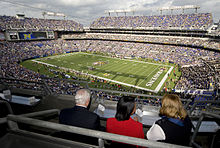
Prior to aNational Football Leagueteam moving to Baltimore, there had been several attempts at a professional football team prior to the 1950s, which were blocked by the Washington team and its NFL friends. Most were minor league orsemi-professionalteams. The first major league to base a team in Baltimore was theAll-America Football Conference(AAFC), which had a team named theBaltimore Colts.The AAFC Colts played for three seasons in the AAFC (1947, 1948, and 1949), and when the AAFC folded following the 1949 season, moved to the NFL for a single year (1950) before going bankrupt.
In 1953, the NFL'sDallas Texansfolded. Its assets and player contracts were purchased by an ownership team headed by Baltimore businessmanCarroll Rosenbloom,who moved the team to Baltimore, establishing a new team also named theBaltimore Colts.During the 1950s and 1960s, the Colts were one of the NFLs more successful franchises, led byPro Football Hall of FamequarterbackJohnny Unitaswho set a then-record of 47 consecutive games with a touchdown pass. The Colts advanced to theNFL Championshiptwice (1958 & 1959) andSuper Bowltwice (1969 & 1971), winning all exceptSuper Bowl IIIin 1969. After the 1983 season, the teamleft Baltimore for Indianapolis in 1984,where they became theIndianapolis Colts.
The NFL returned to Baltimore when the formerCleveland Brownsmoved to Baltimore to become theBaltimore Ravensin 1996. Since then, the Ravens won a Super Bowl championship in2000and2012,sevenAFC Northdivision championships (2003, 2006, 2011, 2012, 2018, 2019 and 2023), and appeared in fiveAFC Championship Games(2000, 2008, 2011, 2012 and 2023).[242]
Baltimore also hosted aCanadian Football Leaguefranchise, theBaltimore Stallionsfor the1994and1995 seasons.Following the 1995 season, and ultimate end to theCanadian Football League in the United Statesexperiment, the team was sold and relocated toMontreal.
Other teams and events
[edit]
The first professional sports organization in the United States,The Maryland Jockey Club,was formed in Baltimore in 1743.Preakness Stakes,the second race in theUnited States Triple Crown of Thoroughbred Racing,has been held every May atPimlico Race Coursein Baltimore since 1873.
Collegelacrosseis a common sport in the spring, as theJohns Hopkins Blue Jaysmen's lacrosse team has won 44 national championships, the most of any program in history. In addition,Loyola Universitywon its first men'sNCAAlacrosse championship in 2012.
TheBaltimore Blastare a professional arenasoccerteam that play in theMajor Arena Soccer Leagueat theSECU Arenaon the campus ofTowson University.The Blast have won nine championships in various leagues, including the MASL. A previous entity of theBlastplayed in theMajor Indoor Soccer Leaguefrom 1980 to 1992, winning one championship. The Baltimore Kings, a Baltimore Blast affiliate,[243]joinedMASL 3in 2021 to begin play in 2022.[244]
FC Baltimore 1729was a semi-professional soccer club in theNPSL league,with the goal of bringing a community-oriented competitive soccer experience to Baltimore. Their inaugural season started on May 11, 2018, and they played their home games atCCBC Essex Field.Baltimore City F.C. is anEastern Premier Soccer Leagueclub that plays since 2023 at Middle Branch Fitness Center inCherry Hill.
TheBaltimore Blueswere a semi-professionalrugby leagueclub which began competition in theUSA Rugby Leaguein 2012.[245]TheBaltimore Bohemianswere an Americansoccer clubwhich competed in theUSL Premier Development League,the fourth tier of theAmerican Soccer Pyramid.Their inaugural season started in the spring of 2012.
TheBaltimore Grand Prixdebuted along the streets of the Inner Harbor section of the city's downtown on September 2–4, 2011. The event played host to theAmerican Le Mans Serieson Saturday and theIndyCar Serieson Sunday. Support races from smaller series were also held, includingIndy Lights.After three consecutive years, on September 13, 2013, it was announced that the event would not be held in 2014 or 2015 due to scheduling conflicts.[246]
The athletic equipment companyUnder Armouris also based in Baltimore. Founded in 1996 byKevin Plank,aUniversity of Marylandalumnus, the company's headquarters are located in Tide Point, adjacent toFort McHenryand theDomino Sugarfactory. TheBaltimore Marathonis the flagship race of several races. The marathon begins atCamden Yardsand travels through many diverse neighborhoods of Baltimore, including the scenic Inner Harbor waterfront area, historic Federal Hill,Fells Point,andCanton, Baltimore.The race then proceeds to other important focal points of the city such asPatterson Park,Clifton Park, Lake Montebello, the Charles Village neighborhood, and the western edge of downtown. After winding through 42.195 kilometres (26.219 mi) of Baltimore, the race ends at virtually the same point at which it starts.
TheBaltimore Brigadewere anArena Football Leagueteam based in Baltimore that, from 2017 to 2019, played atRoyal Farms Arena.In 2019, the team ceased operations along with the rest of the league.
Parks and recreation
[edit]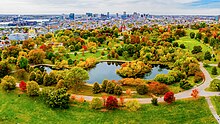
Baltimore has over 4,900 acres (1,983 ha) of parkland.[247]The Baltimore City Department of Recreation and Parks manages the majority of parks and recreational facilities in the city, includingPatterson Park,Federal Hill Park,andDruid Hill Park.[248]The city is home toFort McHenry National Monument and Historic Shrine,a coastal star-shaped fort best known for its role in the War of 1812. As of 2015[update],The Trust for Public Land,a national land conservation organization, ranks Baltimore 40th among the 75-largest U.S. cities.[247]
Law, government, and politics
[edit]Baltimore is anindependent city,and not part of anycounty.For most governmental purposes under Maryland law, Baltimore City is treated as a county-level entity. TheUnited States Census Bureauuses counties as the basic unit for presentation of statistical information in the United States, and treats Baltimore as a county equivalent for those purposes.
Baltimore has been aDemocraticstronghold for over 150 years, with Democrats dominating every level of government. In virtually all elections, the Democratic primary is the real contest.[249]As of the 2020 elections, registered Democrats outnumbered registeredRepublicansby almost 10-to-1.[250]No Republican has been elected to the City Council since 1939. The city's last Republican mayor,Theodore McKeldin,left office in 1967. No Republican candidate since then has received 25 percent or more of the vote. In the2016and2020 mayoral elections,the Republicans were pushed into third place by write-in and independent candidates, respectively. The last Republican candidate for president to win the city wasDwight Eisenhowerin his successful reelection bid in 1956.
The city hosted the first sixDemocratic National Conventions,from 1832 through 1852, and hosted the DNC again in1860,1872,and1912.[251]
Voter registration
[edit]| Voter registration and party enrollment as of March 2024[252] | |||||
|---|---|---|---|---|---|
| Democratic | 296,108 | 75.12% | |||
| Unaffiliated | 62,566 | 15.87% | |||
| Republican | 28,400 | 7.2% | |||
| Libertarian | 1,192 | 0.3% | |||
| Other parties | 5,931 | 1.5% | |||
| Total | 394,197 | 100% | |||
City government
[edit]Mayor
[edit]Brandon Scottis the currentmayor of Baltimore.He was elected in 2020 and took office on December 8, 2020.
Scott succeededJack Young,who took office on May 2, 2019. Young had been the president of theBaltimore City Councilwhen MayorCatherine Pughwas accused of aself-dealingbook-sales arrangement. He became acting mayor on April 2 when she took a leave of absence, then mayor upon her resignation.[253][254]
Pugh, a Democrat, won the2016 mayoral electionwith 57.1% of the vote and took office on December 6, 2016.[255]
Stephanie Rawlings-Blakeassumed the office of Mayor on February 4, 2010, when predecessor Dixon's resignation became effective.[256]Rawlings-Blake had been serving as City Council President at the time. She was elected to a full term in 2011, defeating Pugh in the primary election and receiving 84% of the vote.[257]
Sheila Dixonbecame the first female mayor of Baltimore on January 17, 2007. As the former City Council President, she assumed the office of Mayor when former MayorMartin O'Malleytook office as Governor of Maryland.[258]On November 6, 2007, Dixon won theBaltimore mayoral election.Mayor Dixon's administration ended less than three years after her election, the result of a criminal investigation that began in 2006 while she was still City Council President. She was convicted on a single misdemeanor charge ofembezzlementon December 1, 2009. A month later, Dixon made anAlford pleato aperjurycharge and agreed to resign from office; Maryland, like most states, does not allow convicted felons to hold office.[259][260]

Baltimore City Council
[edit]Grassroots pressure for reform, voiced asQuestion P,restructured the city council in November 2002, against the will of the mayor, the council president, and the majority of the council. A coalition of union and community groups, organized by theAssociation of Community Organizations for Reform Now(ACORN), backed the effort.[261]
Baltimore City Councilis made up of 14 single-member districts and one elected at-large council president.[262][263]
Law enforcement
[edit]
TheBaltimore City Police Departmentis the current primary law enforcement agency serving Baltimore citizens. It was founded 1784 as a "Night City Watch" and day Constables system and later reorganized as a City Department in 1853, with a later reorganization under State of Maryland supervision in 1859, with appointments made by theGovernor of Marylandafter a period of civic and elections violence with riots in the later part of the decade. Campus and building security for the city'spublic schoolsis provided by the Baltimore City Public Schools Police, established in the 1970s.
In the four-year span of 2011 to 2015, 120 lawsuits were brought against Baltimore police for alleged brutality and misconduct. The Freddie Gray settlement of $6.4 million exceeds the combined total settlements of the 120 lawsuits, as state law caps such payments.[264]
Maryland Transportation Authority Policeunder theMaryland Department of Transportation,originally established as the "Baltimore Harbor Tunnel Police" when opened in 1957, is the primary law enforcement agency on the Fort McHenry Tunnel Thruway onI-95and theBaltimore Harbor Tunnel Thruway,which goes underneath the northwestern branch ofPatapsco River,andInterstate 395,which has three ramp bridges crossing the middle branch of the Patapsco River that are underMdTAjurisdiction, and have limited concurrent jurisdiction with theBaltimore Police Departmentunder amemorandum of understanding.
Law enforcement on the fleet of transit buses and transit rail systems serving Baltimore is the responsibility of theMaryland Transit Administration Police,which is part of the Maryland Transit Administration of the stateDepartment of Transportation.The MTA Police also share jurisdiction authority with the Baltimore City Police, governed by a memorandum of understanding.[265]
As the enforcement arm of the Baltimore circuit and district court system, theBaltimore City Sheriff's Office,created by state constitutional amendment in 1844, is responsible for the security of city courthouses and property, service of court-ordered writs, protective and peace orders, warrants, tax levies, prisoner transportation and traffic enforcement. Deputy Sheriffs are sworn law enforcement officials, with full arrest authority granted by the constitution of Maryland, theMaryland Police and Correctional Training Commissionand the Sheriff of Baltimore.[266]
TheUnited States Coast Guard,operating out of their shipyard and facility (since 1899) at Arundel Cove onCurtis Creek,(off Pennington Avenue extending to Hawkins Point Road/Fort Smallwood Road) in theCurtis Baysection of southern Baltimore City and adjacent northern Anne Arundel County. The U.S.C.G. also operates and maintains a presence on Baltimore and Maryland waterways in thePatapsco RiverandChesapeake Bay."Sector Baltimore" is responsible for commanding law enforcement and search & rescue units as well as aids to navigation.
Crime
[edit]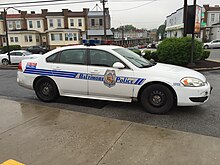
Baltimore is considered one of the most dangerous cities in the U.S.[267]Experts say an emerging gang presence and heavy recruitment of adolescent boys into these gangs, who are statistically more likely to get serious charges reduced or dropped, are major reasons for the sustained crime crises in the city.[268][269]Overall reported crime dropped by 60% from the mid-1990s to the mid-2010s, but homicides and gun violence remain high and far exceed the national average.[270]
The worst years for crime in Baltimore overall were from 1993 to 1996, with 96,243 crimes reported in 1995. Baltimore's 344 homicides in 2015 represented the highest homicide rate in the city's recorded history—52.5 per 100,000 people, surpassing the record ratio set in 1993—and the second-highest for U.S. cities behindSt. Louisand ahead ofDetroit.Of Baltimore's 344 homicides in 2015, 321 (93.3%) of the victims were African-American.[270]
Drug use and deaths by drug use, particularly drugs used intravenously, such as heroin, are a related problem which has impaired Baltimore for decades. Among cities greater than 400,000, Baltimore ranked 2nd in its opiate drug death rate in the United States. TheDEAreported that 10% of Baltimore's population – about 64,000 people – are addicted to heroin, most of which is trafficked into the city from New York.[271][272][273][274][275]
In 2011, Baltimore police reported 196 homicides, the lowest number in the city since 197 homicides in 1978, and far lower than the peak homicide count of 353 slayings in 1993. City leaders at the time credited a sustained focus on repeat violent offenders and increased community engagement for the continued drop, reflecting a nationwide decline in crime.[276][277]
In August 2014, Baltimore's new youthcurfewlaw went into effect. It prohibits unaccompanied children under age 14 from being on the streets after 9 p.m. and those aged 14–16 from being out after 10 p.m. during the week and 11 p.m. on weekends and during the summer. The goal is to keep children out of dangerous places and reduce crime.[278]
Crime in Baltimore reached another peak in 2015 when the year's tally of 344 homicides was second only to the record 353 in 1993, when Baltimore had about 100,000 more residents. The killings in 2015 were on pace with recent years in the early months of 2015, but skyrocketed after theunrest and rioting of late Aprilfollowing thekilling of Freddie Grayby police. In five of the next eight months, killings topped 30–40 per month. Nearly 90 percent of 2015's homicides resulted from shootings, renewing calls for new gun laws. In 2016, there were 318 murders in the city.[279]This total marked a 7.56 percent decline in homicides from 2015.
In an interview withThe Guardianon November 2, 2017,[280]David Simon,himself a former police reporter forThe Baltimore Sun,ascribed the most recent surge in murders to the high-profile decision by Baltimore state's attorney,Marilyn Mosby,to charge six city police officers following thedeath of Freddie Grayafter he was paralyzed during a "rough-ride" in a police van while in police custody in April 2015, dying from the injury a week later. "What Mosby basically did was send a message to the Baltimore police department: 'I'm going to put you in jail for making a bad arrest.' So officers figured it out: 'I can go to jail for making the wrong arrest, so I'm not getting out of my car to clear a corner,' and that's exactly what happened post-Freddie Gray."[280]
In Baltimore, "arrest numbers have plummeted from more than 40,000 in 2014, the year before Gray's death and the charges against the officers, to about 18,000 [as of November 2017]. This happened as homicides soared from 211 in 2014 to 344 in 2015 – an increase of 63%."[280]Simon's HBO miniseriesWe Own This Cityaired in April 2022 and covered many of the events surrounding the death of Freddie Gray and the workslowdownby the Baltimore Police Department during that time period.
In the six years between 2016 and 2022, Baltimore tallied 318, 342, 309, 348, 335, 338, and 335 homicides, respectively.[281]In 2023, Baltimore saw a 20% drop in homicides to 263.[282]
Baltimore City Fire Department
[edit]Baltimore is protected by the over 1,800 professional firefighters of the Baltimore City Fire Department (BCFD). It was founded in December 1858 and began operating the following year. Replacing several warring independent volunteer companies since the 1770s and the confusion resulting froma riotinvolving the "Know-Nothing"political party two years before, the establishment of a unified professional fire fighting force was a major advance in urban governance. The BCFD operates out of 37 fire stations located throughout the city and has a long history and sets of traditions in its various houses and divisions.
State government
[edit]This article needs to beupdated.(December 2019) |
Since the legislativeredistrictingin 2002, Baltimore has had six legislative districts located entirely within its boundaries, giving the city six seats in the 47-memberMaryland Senateand 18 in the 141-memberMaryland House of Delegates.[283][284]During the previous 10-year period, Baltimore had four legislative districts within the city limits, but four others overlapped the Baltimore County line.[285]As of January 2011[update],all of Baltimore's state senators and delegates were Democrats.[283]
State agencies
[edit]Federal government
[edit]Two of the state's eightcongressional districtsinclude portions of Baltimore: the2nd,represented byDutch Ruppersbergerand the7th,represented byKweisi Mfume.Both are Democrats. A Republican has not represented a significant portion of Baltimore in Congress sinceJohn Boynton Philip Clayton Hillrepresented the 3rd District in 1927, and has not represented any of Baltimore since theEastern Shore-based 1st District lost its share of Baltimore after the 2000 census. It was represented by RepublicanWayne Gilchrestat the time.
Maryland's seniorUnited States senator,Ben Cardin,is from Baltimore. He is one of three people in the last four decades to have represented the 3rd District before being elected to theUnited States Senate.Paul Sarbanesrepresented the 3rd from 1971 until 1977, when he was elected to the first of five terms in the Senate. Sarbanes was succeeded byBarbara Mikulski,who represented the 3rd from 1977 to 1987. Mikulski was succeeded by Cardin, who held the seat until handing it to John Sarbanes upon his election to the Senate in 2007.[286]
| Year | Republican | Democratic | Third party | |||
|---|---|---|---|---|---|---|
| No. | % | No. | % | No. | % | |
| 2020 | 25,374 | 10.69% | 207,260 | 87.28% | 4,827 | 2.03% |
| 2016 | 25,205 | 10.53% | 202,673 | 84.66% | 11,524 | 4.81% |
| 2012 | 28,171 | 11.09% | 221,478 | 87.19% | 4,356 | 1.71% |
| 2008 | 28,681 | 11.66% | 214,385 | 87.16% | 2,902 | 1.18% |
| 2004 | 36,230 | 16.96% | 175,022 | 81.95% | 2,311 | 1.08% |
| 2000 | 27,150 | 14.11% | 158,765 | 82.52% | 6,489 | 3.37% |
| 1996 | 28,467 | 15.53% | 145,441 | 79.34% | 9,415 | 5.14% |
| 1992 | 40,725 | 16.62% | 185,753 | 75.79% | 18,613 | 7.59% |
| 1988 | 59,089 | 25.43% | 170,813 | 73.51% | 2,465 | 1.06% |
| 1984 | 80,120 | 28.20% | 202,277 | 71.18% | 1,766 | 0.62% |
| 1980 | 57,902 | 21.87% | 191,911 | 72.48% | 14,962 | 5.65% |
| 1976 | 81,762 | 31.40% | 178,593 | 68.60% | 0 | 0.00% |
| 1972 | 119,486 | 45.15% | 141,323 | 53.40% | 3,843 | 1.45% |
| 1968 | 80,146 | 27.65% | 178,450 | 61.56% | 31,288 | 10.79% |
| 1964 | 76,089 | 24.02% | 240,716 | 75.98% | 0 | 0.00% |
| 1960 | 114,705 | 36.13% | 202,752 | 63.87% | 0 | 0.00% |
| 1956 | 178,244 | 55.90% | 140,603 | 44.10% | 0 | 0.00% |
| 1952 | 166,605 | 47.62% | 178,469 | 51.01% | 4,784 | 1.37% |
| 1948 | 110,879 | 43.67% | 134,615 | 53.02% | 8,396 | 3.31% |
| 1944 | 112,817 | 40.83% | 163,493 | 59.17% | 0 | 0.00% |
| 1940 | 112,364 | 35.56% | 199,715 | 63.20% | 3,917 | 1.24% |
| 1936 | 97,667 | 31.48% | 210,668 | 67.89% | 1,959 | 0.63% |
| 1932 | 78,954 | 31.94% | 160,309 | 64.84% | 7,969 | 3.22% |
| 1928 | 135,182 | 51.39% | 126,106 | 47.94% | 1,770 | 0.67% |
| 1924 | 69,588 | 42.63% | 60,222 | 36.89% | 33,442 | 20.48% |
| 1920 | 125,526 | 57.02% | 86,748 | 39.40% | 7,872 | 3.58% |
| 1916 | 49,805 | 44.31% | 60,226 | 53.58% | 2,382 | 2.12% |
| 1912 | 15,597 | 15.70% | 48,030 | 48.36% | 35,695 | 35.94% |
| 1908 | 51,528 | 49.82% | 49,139 | 47.51% | 2,756 | 2.66% |
| 1904 | 47,444 | 48.64% | 47,901 | 49.11% | 2,192 | 2.25% |
| 1900 | 58,880 | 52.10% | 51,979 | 46.00% | 2,149 | 1.90% |
| 1896 | 61,965 | 58.13% | 40,859 | 38.33% | 3,777 | 3.54% |
| 1892 | 36,492 | 40.79% | 51,098 | 57.12% | 1,867 | 2.09% |
ThePostal Service's Baltimore Main Post Office is located at 900 East Fayette Street in theJonestownarea.[288]
The national headquarters for theUnited States Social Security Administrationis located in Woodlawn, just outside of Baltimore.
Education
[edit]Colleges and universities
[edit]Baltimore is the home of numerous places of higher learning, both public and private. 100,000 college students from around the country attend Baltimore City's 10 accredited two-year or four-year colleges and universities.[289][290]Among them are:
Private
[edit]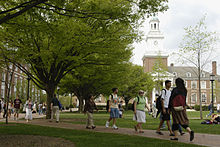
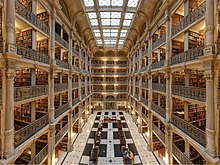
- Johns Hopkins University
- Loyola University Maryland
- Maryland Institute College of Art
- St. Mary's Seminary and University
- Notre Dame of Maryland University
- ThePeabody Instituteof Johns Hopkins University
Public
[edit]- Baltimore City Community College
- Coppin State University
- Morgan State University
- University of Baltimore
- University of Maryland, Baltimore
Primary and secondary schools
[edit]The city's public schools are managed byBaltimore City Public Schools,[292]and include:Carver Vocational-Technical High School,the first African American vocational high school and center that was established in the state of Maryland;Digital Harbor High School,one of the secondary schools that emphasizesinformation technology,Lake Clifton Eastern High School,which is the largest school campus in Baltimore in physical size, the historicFrederick Douglass High School,which is the second oldest African American high school in the United States;[293]Baltimore City College,the third-oldest public high school in the nation,[294]andWestern High School,the oldest public all-girls school in the nation.[295]
Baltimore City College andBaltimore Polytechnic Instituteshare the nation's second-oldest high schoolfootball rivalry.[296]
Transportation
[edit]
Baltimore has a higher-than-average percentage of households without a car. In 2015, 30.7 percent of Baltimore households lacked a car, which decreased slightly to 28.9 percent in 2016. The national average was 8.7 percent in 2016. Baltimore averaged 1.65 cars per household in 2016, compared to a national average of 1.8.[297]
Roads and highways
[edit]
Baltimore's highway growth has done much to influence the development of the city and its suburbs. The firstlimited-access highwayserving Baltimore was theBaltimore–Washington Parkway,which opened in stages between 1950 and 1954. Maintenance of it is split: the half closest to Baltimore is maintained by the state of Maryland, and the half closest to Washington by theNational Park Service.Trucks are only permitted to use the northern part of the parkway. Trucks (tractor-trailers) continued to useU.S. Route 1(US 1) untilInterstate 95(I-95) between Baltimore and Washington opened in 1971.
The Interstate highways serving Baltimore areI-70,I-83(the Jones Falls Expressway), I-95,I-395,I-695(the Baltimore Beltway),I-795(the Northwest Expressway),I-895(the Harbor Tunnel Thruway), andI-97.The city's mainline Interstate highways—I-95, I-83, and I-70—do not directly connect to each other, and in the case of I-70 end at a park and ride lot just inside the city limits, because offreeway revoltsin Baltimore. These revolts were led primarily byBarbara Mikulski,a formerUnited States senatorfor Maryland, which resulted in the abandonment of the original plan.
There are two tunnels traversing Baltimore Harbor within the city limits: the four-boreFort McHenry Tunnel(opened in 1985 and serving I-95) and the two-boreHarbor Tunnel(opened in 1957 and serving I-895). Untilits collapse in March 2024,the Baltimore Beltway crossed south of Baltimore Harbor over theFrancis Scott Key Bridge.
The first interstate highway built in Baltimore wasI-83,called the Jones Falls Expressway (first portion built in the early 1960s). Running from the downtown toward the northwest (NNW), it was built through a natural corridor over theJones Falls River,which meant that no residents or housing were directly displaced. A planned section from what is now its southern terminus to I-95 was abandoned. Its route through parkland received criticism.
Planning for the Baltimore Beltway antedates the creation of theInterstate Highway System.The first portion completed was a small strip connecting the two sections of I-83, the Baltimore-Harrisburg Expressway and the Jones Falls Expressway.
The onlyU.S. Highwaysin the city are US 1, which bypasses downtown, andUS 40,which crosses downtown from east to west. Both run along major surface streets, US 40 utilizes a small section of a freeway cancelled in the 1970s in the west side of the city, originally intended forInterstate 170.State routes in the city travel along surface streets, with the exception ofMaryland Route 295,which carries the Baltimore–Washington Parkway.
The Baltimore City Department of Transportation (BCDOT) is responsible for several functions of the road transportation system in Baltimore, including repairing roads, sidewalks, and alleys; road signs; street lights; and managing the flow of transportation systems.[298]In addition, the agency is in charge of vehicle towing andtraffic cameras.[299][300]
BCDOT maintains all streets within the Baltimore. These include all streets that are marked as state and U.S. highways and portions ofI-83andI-70within Baltimore's city limits. The only highways in the city that are not maintained by BCDOT areI-95,I-395,I-695,andI-895,which are maintained by theMaryland Transportation Authority.[301]
Transit systems
[edit]Public transit
[edit]
Public transit in Baltimore is mostly provided by theMaryland Transit Administration(abbreviated "MTA Maryland" ) andCharm City Circulator.MTA Maryland operates a comprehensivebusnetwork, including many local, express, and commuter buses,a light rail networkconnectingHunt Valleyin the north to BWI Airport andGlen Burniein the south, and asubway linebetweenOwings MillsandJohns Hopkins Hospital.[302]A proposed rail line, known as theRed Line,which would link theSocial Security Administration's headquarters inWoodlawntoJohns Hopkins Bayview Medical Centerin East Baltimore, was cancelled in June 2015 by former GovernorLarry Hogan.In June 2023, GovernorWes Mooreannounced the relaunch of the Red Line project.[303]
The Charm City Circulator (CCC), ashuttle bus serviceoperated by First Transit for the Baltimore City Department of Transportation, began operating in the downtown area in January 2010. Funded partly by a 16 percent increase in the city's parking fees, the Circulator provides free bus service seven days a week, picking up passengers every 15–25 minutes at designated stops during service hours.[304][305]The Charm City Circulator consists of four routes, the Green Route runs from City Hall to Johns Hopkins Hospital via Fells Point, the Purple Route runs from 33rd Street to Federal Hill, the Orange Route runs between Hollins Market and Harbor East, and the Banner Route runs from the Inner Harbor toFort McHenry.[306]
Baltimore has awater taxiservice, operated byBaltimore Water Taxi.The water taxi's six routes provide service throughout the city's harbor, and was purchased byUnder ArmourCEOKevin Plank's Sagamore Ventures in 2016.[307]
In June 2017, the BaltimoreLink bus network redesign was launched. The BaltimoreLink redesign consisted of a dozen high frequency, color-coded routes branded CityLink, running every 10 to 15 minutes through downtown Baltimore, along with changes to local and express bus service, rebranded LocalLink and ExpressLink.[308]
Intercity rail
[edit]
Baltimore is a top destination forAmtrakalong theNortheast Corridor.Baltimore'sPenn Stationis one of the busiest in the country. As of 2014, Penn Station was ranked theseventh-busiestrail station in theUnited Statesby number of passengers served each year.[309]The building sits on a raised "island" of sorts between two open trenches, one for the Jones Falls Expressway and the other for the tracks of the Northeast Corridor (NEC). The NEC approaches from the south through the two-track, 7,660 feet (2,330 m)Baltimore and Potomac Tunnel,which opened in 1873 and whose 30 mph (50 km/h) limit, sharp curves, and steep grades make it one of the NEC's worst bottlenecks. The NEC's northern approach is the 1873Union Tunnel,which has onesingle-trackbore and onedouble-trackbore.
Just outside the city,Baltimore/Washington International (BWI) Thurgood Marshall Airport Rail Stationis another stop. Amtrak'sAcela Express,Palmetto,Carolinian,Silver Star,Silver Meteor,Vermonter,Crescent,andNortheast Regionaltrains are the scheduled passenger train services that stop in the city.MARCcommuter rail service connects the city's two main intercity rail stations, Camden Station and Penn Station, with Washington, D.C.'sUnion Stationas well as stops in between. The MARC consists of 3 lines; the Brunswick, Camden and Penn. On December 7, 2013, the Penn Line began weekend service.[310]
Airports
[edit]
Baltimore is served by two airports, both operated by the Maryland Aviation Administration, which is part of theMaryland Department of Transportation.[311]Baltimore–Washington International Thurgood Marshall Airport,generally known as "BWI", lies about 10 miles (16 km) to the south of Baltimore in neighboring Anne Arundel County. The airport is named afterThurgood Marshall,a Baltimore native who was the first African American to serve on theSupreme Court of the United States.In terms of passenger traffic, BWI is the 22nd busiest airport in the United States.[312]As of 2014, BWI is the largest, by passenger count, of three major airports serving theBaltimore–Washington Metropolitan Area.It is accessible byI-95and the Baltimore–Washington Parkway viaInterstate 195,theBaltimore Light Rail,and Amtrak and MARC Train atBWI Rail Station.
Baltimore is also served byMartin State Airport,ageneral aviationfacility, to the northeast in Baltimore County. Martin State Airport is linked todowntown BaltimorebyMaryland Route 150(Eastern Avenue) and by MARC Train atits own station.
Pedestrians and bicycles
[edit]Baltimore has a comprehensive system of bicycle routes in the city. These routes are not numbered, but are typically denoted with green signs displaying a silhouette of a bicycle upon an outline of the city's border, and denote the distance to destinations, much like bicycle routes in the rest of the state. The roads carrying bicycle routes are also labelled with either bike lanes, sharrows, or Share the Road signs. Many of these routes pass through the downtown area. The network of bicycle lanes in the city continues to expand, with over 140 miles (230 km) added between 2006 and 2014.[313]Alongside bike lanes, Baltimore has also builtbike boulevards,starting with Guilford Avenue in 2012.
Baltimore has three major trail systems within the city. TheGwynns Falls Trailruns from the Inner Harbor to the I-70 Park and Ride, passing throughGwynns Falls Parkand possessing numerous branches. There are also many pedestrian hiking trails traversing the park. TheJones Falls Trailruns from the Inner Harbor to the Cylburn Arboretum. It is undergoing expansion. Long-term plans call for it to extend to theMount Washington Light Rail Stop,and possibly as far north as the Falls Road stop to connect to the Robert E. Lee boardwalk north of the city. It will incorporate a spur alongside Western Run. The two aforementioned trails carry sections of theEast Coast Greenwaythrough the city.
The Herring Run Trail runs fromHarford Roadeast, to its end beyond Sinclair Lane, utilizing Herring Run Park. Long-term plans call for its extension toMorgan State Universityand north to points beyond. Other major bicycle projects include a protected cycle track installed on both Maryland Avenue and Mount Royal Avenue, expected to become the backbone of a downtown bicycle network. Installation for the cycletracks is expected in 2014 and 2016, respectively.
In addition to the bicycle trails and cycletracks, Baltimore has the Stony Run Trail, a walking path that will eventually connect from the Jones Falls north to Northern Parkway, utilizing much of the old Ma and Pa Railroad corridor inside the city. In 2011, the city undertook a campaign to reconstruct many sidewalk ramps in the city, coinciding with mass resurfacing of the city's streets. A 2011 study byWalk Scoreranked Baltimore the 14th-most walkable of fifty largest U.S. cities.[314]
Port of Baltimore
[edit]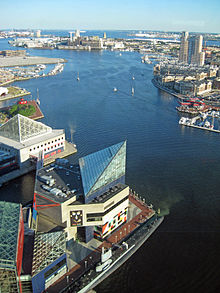
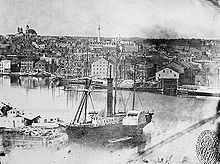
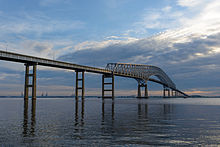
The port was founded in 1706, preceding the founding of Baltimore. The Maryland colonial legislature made the area nearLocust Pointas theport of entryfor thetobaccotrade with England. Fells Point, the deepest point in the natural harbor, soon became the colony's main ship building center, later on becoming leader in the construction ofclipper ships.[315]
After Baltimore's founding, mills were built behind the wharves. TheCalifornia Gold Rushled to many orders for fast vessels. Many overland pioneers also relied upon canned goods from Baltimore. After the Civil War, a coffee ship was designed here for trade withBrazil.At the end of the nineteenth century, European ship lines had terminals for immigrants. The Baltimore and Ohio Railroad made the port a majortransshipmentpoint.[316]: 17, 75 The port has majorroll-on/roll-offfacilities, as well as bulk facilities, especially steel handling.[317]
Water taxisoperate in the Inner Harbor. Governor Ehrlich participated in naming the port afterHelen Delich Bentleyduring the 300th anniversary of the port.[318]
In 2007,Duke RealtyCorporation began a new development near the Port of Baltimore, named the Chesapeake Commerce Center. This new industrial park is located on the site of a former General Motors plant. The total project comprises 184 acres (0.74 km2) in eastern Baltimore City, and the site will yield 2,800,000 square feet (260,000 m2) of warehouse/distribution and office space. Chesapeake Commerce Center has direct access to two major Interstate highways (I-95andI-895) and is located adjacent to two of the major Port of Baltimore terminals. The Port of Baltimore is one of two seaports on the U.S. East Coast with a 50-foot (15 m) dredge to accommodate the largest shipping vessels.[319]
Along with cargo terminals, the port also has a passenger cruise terminal, which offers year-round trips on several lines, including Royal Caribbean's Grandeur of the Seas and Carnival's Pride. Overall five cruise lines have operated out of the port to the Bahamas and the Caribbean, while some ships traveled to New England and Canada. The terminal has become an embarkation point where passengers have the opportunity to park and board next to the ship visible from Interstate 95.[320]
Passengers fromPennsylvania,New York,andNew Jerseymake up a third of the volume, with travelers from Maryland,Virginia,Washington, D.C.and other regions accounting for the rest.[321]
Environment
[edit]Baltimore's Inner Harbor, known for its skyline waterscape and its tourist-friendly areas, was horribly polluted. The waterway was often filled with garbage after heavy rainstorms, failing its 2014 water quality report card. The Waterfront Partnership of Baltimore took steps to remediate the waterways, in hopes that the harbor would be fishable and swimmable once again.
Trash interceptors
[edit]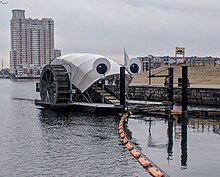
Baltimore has four water wheel trash interceptors for removing garbage in area waterways. One is at the mouth ofJones Fallsin Baltimore's Inner Harbor, dubbed "Mr. Trash Wheel".[322]Another, "Professor Trash Wheel" was added at Harris Creek in theCantonneighborhood in 2016,[323][324]with "Captain Trash Wheel" following at Mason Creek in 2018[325]and "Gwynnda, the Good Wheel of the West" at the mouth of theGwynns Fallsin 2021.[326]A February 2015 agreement with a local waste-to-energy plant is believed to make Baltimore the first city to use reclaimed waterway debris to generate electricity.[327]
Other water pollution control
[edit]In August 2010, the National Aquarium assembled, planted, and launched afloating wetland islanddesigned by Biohabitats in Baltimore's Inner Harbor.[328]Hundreds of years ago, Baltimore's harbor shoreline would have been lined with tidalwetlands.Floating wetlands provide many environmental benefits to water quality and habitat enhancement, which is why the Waterfront Partnership of Baltimore has included them in their Healthy Harbor Initiative pilot projects.[329]Biohabitats also developed a concept to transform a dilapidated wharf into a living pier that cleans Harbor water, provides habitat and is an aesthetic attraction. Currently under design, the top of the pier will become aconstructed tidal wetland.[330]
Other projects to improve water quality include the Blue Alleys project, expanded street sweeping, and stream restoration.[322]
Air quality and pollution
[edit]Since 1985 theWheelabrator incinerator,formerly known as the Baltimore Refuse Energy Systems Co., has operated as awaste-to-energyincinerator. The incinerator is a significant source of air pollution to nearby neighborhoods. Several environmental groups, such as theEnvironmental Integrity Project,and theChesapeake Climate Action Network,have been successful in advocating for reinforced pollution monitoring. According to Shashawnda Campbell, the incinerator is "the city's single largest standing source of air pollution".[331]
Media
[edit]Baltimore's main media outlet since 2010 isThe Baltimore Sunwhich was sold by its Baltimore owners in 1986 to the Times Mirror Company,[332]and then bought by theTribune Companyin 2000.[333]Since the sale,The Baltimore Sunprints some local news along with regional and national articles. TheBaltimore News-American,another long-running paper that competed with the Sun, ceased publication in 1986.[334]
The city is home to theBaltimore Afro-American,an influential African American newspaper founded in 1892.[335][336]
In 2006,The Baltimore Examinerwas launched to compete withThe Sun.It was part of a national chain that includesThe San Francisco ExaminerandThe Washington Examiner.In contrast to the paid subscriptionSun,The Examinerwas a free newspaper funded solely by advertisements. Unable to turn a profit and facing a deep recession,The Baltimore Examinerceased publication on February 15, 2009.[337]
Despite being located 40 miles northeast ofWashington, D.C.,Baltimore is a major media market in its own right, with all major English language television networks represented in the city.WJZ-TV13 is aCBSowned and operated station,andWBFF45 (Fox) is the flagship ofSinclair Broadcast Group,the largest station owner in the country. Other major television stations in Baltimore includeWMAR-TV2 (ABC),WBAL-TV11 (NBC),WUTB24 (TBD),WBFF-DT245.2 (MyNetworkTV),WNUV54 (CW), andWMPB67 (PBS). Baltimore is also served by low-power stationWMJF-CD39 (Ion), which transmits from the campus ofTowson University.
Nielsen ranked Baltimore as the 27th-largesttelevision marketin 2009.[338]Arbitron's Fall 2010 rankings identified Baltimore as the 22nd-largest radio market.[339]
Notable people
[edit]- Spiro Agnew,39thU.S. vice presidentunderRichard Nixon
- Eubie Blake,jazz pianist and composer
- Muggsy Bogues,former professional basketball player
- Julie Bowen,actress
- Christine Michel Carter,author and marketing strategist
- Tom Clancy,author of theRyanversebook series
- Elijah Cummings,former U.S. Congressman and civil rights activist
- Gervonta Davis,professional boxer and four-time world champion in two weight classes
- Temi Fagbenle,WNBAplayer
- Cass Elliot,born Ellen Naomi Cohen, singer and member ofthe Mamas & the Papas
- Daniel Coit Gilman,founding president ofJohns Hopkins University
- Stavros Halkias,stand-up comedian
- Kyle Harrison,professional lacrosse player and first blackTewaaraton Awardrecipient
- David Hasselhoff,actor, producer, and businessman
- Billie Holiday,singer of jazz, swing and pop music
- Johns Hopkins,entrepreneur, investor, philanthropist, and namesake ofJohns Hopkins University
- Francis Scott Key,lawyer, poet, and anti-abolitionist
- Laura Lippman,journalist and novelist
- Thurgood Marshall,U.S. Supreme Courtjustice
- H. L. Mencken,journalist, essayist, satirist, cultural critic, and scholar ofAmerican English
- Joe Metheny,serial killer and cannibal
- Ric Ocasek,rock musician and lead singer ofthe Cars
- Bob Parsons,Entrepreneur, billionaire, and philanthropist; founded theGoDaddygroup of companies
- Nancy Pelosi,formerSpeaker of the U.S. House of Representatives
- Michael Phelps,swimmer andall-time leader in Olympic medals
- Edgar Allan Poe,poet
- Emily Post,author ofetiquettebooks
- Lance Reddick,actor and musician
- Babe Ruth,professional baseball player andBaseball Hall of Fameinductee
- Tupac Shakur,musician, actor, poet and activist
- Wallis Simpson,Duchess of Windsor
- Jada Pinkett Smith,actress, singer, and businesswoman
- M. Carey Thomas,educator,suffragist,and linguist
- Anne Tyler,Pulitzer Prize-winning novelist
- John Waters,filmmaker
- D. Watkins,screenwriter, author, public intellectual
- Biddy Wood,journalist and jazz promoter
- Frank Zappa,rock musician
International relations
[edit]Baltimore has elevensister cities,as designated bySister Cities International.[340][341]Baltimore's own Sister City Committees recognize nine of these sister cities, which are shaded yellow and marked with adagger(†):[342]
| City | Country | Year designated |
|---|---|---|
| Alexandria† | Egypt | 1995 |
| Ashkelon | Israel | 1974 |
| Bendigo[citation needed] | Australia | 2023 |
| Changwon† | South Korea | 2018 |
| Gbarnga† | Liberia | 1973 |
| Kawasaki† | Japan | 1979 |
| Luxor† | Egypt | 1995 |
| Odesa† | Ukraine | 1974 |
| Piraeus† | Greece | 1982 |
| Rotterdam† | Netherlands | 1985 |
| Xiamen† | China | 1985 |
Three additional sister cities have "emeritus status":[340]
| City | Country | Year designated |
|---|---|---|
| Genoa[343] | Italy | 1985 |
| Ely O'Carroll | Ireland | |
| Bremerhaven | Germany | 2007 |
See also
[edit]- Baltimore Development Corporation
- Baltimore in fiction
- Baltimore National Heritage Area
- Bluegrass in Baltimore: The Hard Drivin' Sound and Its Legacy(Book on the history of theAppalachian migrants' move into the city in the 20th century)
- History of the Germans in Baltimore, Maryland
- USSBaltimore,6 ships
- Category:Cemeteries in Baltimore
 Baltimore portal
Baltimore portal
Explanatory notes
[edit]- ^/ˈbɔːltɪmɔːr/BAWL-tim-or,locally:/ˌbɔːldɪˈmɔːr/BAWL-dim-ORor/ˈbɔːlmər/BAWL-mər[14]
- ^The form and type of government of the city is described by Article XI of the State Constitution.
- ^Officially, seasonal snowfall accumulation has ranged from 0.7 in (1.8 cm) in 1949–50 to 77.0 in (196 cm) in 2009–10. SeeNorth American blizzard of 2009#Snowfall(December 19–20, 2009),February 5–6, 2010 North American blizzard#Snowfall,andFebruary 9–10, 2010 North American blizzard#Impact.The February storms contributed to a monthly accumulation of 50.0 in (127 cm), the most for any month.[147]If no snow fell outside of February that winter, 2009–10 would still rank as 5th snowiest.[148]
- ^Since 1950, when the National Weather Service switched to using the suburban and generally cooler BWI Airport as the official Baltimore climatology station, this extreme has repeated three times: January 29, 1963,January 17, 1982,and January 22, 1984.
- ^Mean monthly maxima and minima (i.e. the expected highest and lowest temperature readings at any point during the year or given month) calculated based on data at said location from 1991 to 2020.
- ^For more information, seeThreadEx
- ^abFrom 15% sample
- ^IncludingEvangelical Protestants(19%),Mainline Protestants(16%) and HistoricallyBlack Protestants(15%).[189]
References
[edit]Citations
[edit]- ^abcDonovan, Doug (May 20, 2006)."Baltimore's New Bait: The City is About to Unveil a New Slogan, 'Get In On It,' Meant to Intrigue Visitors".The Baltimore Sun.RetrievedNovember 28,2008– via RedOrbit.
- ^Kane, Gregory(June 15, 2009)."Dispatch from Bodymore, Murderland".The Washington Examiner.
- ^Cutler, Josh S. (February 18, 2019).Mobtown Massacre: Alexander Hanson and the Baltimore Newspaper War of 1812.Arcadia.ISBN978-1-4396-6620-3.
- ^Gettleman, Jeffrey(September 2, 2003)."In Baltimore, Slogan Collides with Reality".The New York Times.
- ^"2019 U.S. Gazetteer Files".United States Census Bureau.RetrievedJuly 25,2020.
- ^ab"Highest and Lowest Elevations in Maryland's Counties".Maryland Geological Survey.Maryland Department of Natural Resources. Baltimore City.Archivedfrom the original on October 5, 2007.RetrievedNovember 14,2007.
- ^ab"Total Resident Population for Maryland's Jurisdictions, April 1, 2010 Thru July 1, 2020"(PDF).Maryland Department of Planning, Projections and State Data Center Unit. May 4, 2021.RetrievedJuly 29,2021.
- ^"List of 2020 Census Urban Areas".census.gov.United States Census Bureau.RetrievedJanuary 8,2023.
- ^"2020 Population and Housing State Data".United States Census Bureau.RetrievedAugust 22,2021.
- ^Spaniel, Bill (October 31, 2019)."Demonyms find their place in our lexicon and across the country".prdaily.com.Ragan PR Daily/Ragan Insider.RetrievedJuly 29,2023.
- ^"Gross Domestic Product by County and Metropolitan Area, 2022"(PDF).www.bea.gov.Bureau of Economic Analysis.
- ^"Total Gross Domestic Product for Baltimore-Columbia-Towson, MD (MSA)".fred.stlouisfed.org.
- ^"ZIP Code Lookup".USPS. Archived fromthe originalon November 22, 2010.RetrievedOctober 13,2014.
- ^Britto, Brittany."How Baltimore talks".The Baltimore Sun.Archived fromthe originalon August 7, 2022.RetrievedSeptember 9,2022.
- ^abcdef"QuickFacts: Baltimore city (County)".United States Census Bureau.RetrievedAugust 16,2021.
- ^ab"Metropolitan and Micropolitan Statistical Areas Population Totals: 2020–2021"(CSV).2021 Population Estimates.United States Census Bureau,Population Division. May 2022.RetrievedMay 29,2022.
- ^Youssi, Adam (2006)."The Susquehannocks' Prosperity & Early European Contact".Historical Society of Baltimore County.RetrievedApril 28,2015.
- ^"About Baltimore".Baltimore.org. Archived fromthe originalon July 25, 2013.RetrievedJuly 8,2013.
- ^"Baltimore Heritage Area".Maryland Historical Trust.February 11, 2011. Archived fromthe originalon February 2, 2012.RetrievedDecember 30,2011.
- ^"Major Employers | Baltimore Development Corporation".Baltimoredevelopment.com. Archived fromthe originalon July 25, 2010.RetrievedJuly 8,2013.
- ^Gibbons, Mike (October 21, 2011)."Monumental City Welcomes Number Five".Babe Ruth Birthplace Foundation.RetrievedFebruary 6,2016.
- ^abSherman, Natalie (March 14, 2015)."Historic districts proliferate as city considers changes".The Baltimore Sun.Archivedfrom the original on July 11, 2017.
- ^"Building on Baltimore's History: The Partnership for Building Reuse"(PDF).Preservation Green Lab, National Trust for Historic Preservation and the Urban Land Institute Baltimore. November 2014. Archived fromthe original(PDF)on October 10, 2017.RetrievedJuly 11,2017.
- ^abAkerson, Louise A. (1988).American Indians in the Baltimore area.Baltimore, Maryland: Baltimore Center for Urban Archaeology (Md.). p. 15.OCLC18473413.
- ^Shen, Fern (December 4, 2021)."Discovered in Baltimore park: Native American artifacts 5,000-9,000 years old".Baltimore Brew.RetrievedDecember 5,2021.
- ^Potter, Stephen R. (1993).Commoners, Tribute, and Chiefs: The Development of Algonquian Culture in the Potomac Valley.Charlottesville, Virginia: University of Virginia Press. p. 119.ISBN978-0-8139-1422-0.RetrievedJanuary 5,2013.
- ^Baltimore City, Maryland: Historical Chronology,Maryland State Archives, February 29, 2016,retrievedApril 11,2016;Calvert Family Tree(PDF),University Libraries, University of Maryland,retrievedApril 11,2016
- ^Maryland History Timeline,Maryland Office of Tourism,retrievedApril 11,2016
- ^abcEgan, Casey (November 23, 2015),"The surprising Irish origins of Baltimore, Maryland",IrishCentral,retrievedApril 11,2016
- ^Brugger, Robert J. (1988).Maryland: A Middle Temperament, 1634–1980.Baltimore: Johns Hopkins Press. p. 4.ISBN978-0-8018-3399-1.
- ^Adam Youssi (2006)."The Susquehannocks' Prosperity & Early European Contact".Historical Society of Baltimore County.RetrievedApril 28,2015.
- ^Alex J. Flick; et al. (2012)."A Place Now Known Unto Them: The Search for Zekiah Fort"(PDF).Site Report:11.RetrievedApril 28,2015.
- ^Murphree, Daniel Scott (2012).Native America: A State-by-State Historical Encyclopedia.Santa Barbara, California:ABC-CLIO.pp. 489, 494.ISBN978-0-313-38126-3.RetrievedApril 28,2015.
- ^As depicted on a map of the Piscataway lands in Kenneth Bryson,Images of America: Accokeek(Arcadia Publishing, 2013) pp. 10–11, derived from Alice and Henry Ferguson,The Piscataway Indians of Southern Maryland(Alice Ferguson Foundation, 1960) pp. 8 (map) and 11: "By the beginning of Maryland settlement, pressure from theSusquehannockshad reduced...the Piscataway 'empire'...to a belt bordering the Potomac south of the falls and extending up the principal tributaries. Roughly, the 'empire' covered the southern half of present Prince Georges County and all, or nearly all, of Charles County. "
- ^"St. Clements Island State Park".Maryland Department of Natural Resources.RetrievedNovember 19,2018.
- ^abBrooks & Rockel (1979), pp. 1–3.
- ^abTom (March 10, 2014)."Baltimore History Traced in Street Names".Ghosts of Baltimore.RetrievedFebruary 24,2019.
- ^Bacon, Thomas(1765).Laws of Maryland at Large, with Proper Indexes.Vol. 75. Annapolis: Jonas Green. p. 61.
- ^Brooks & Rockel (1979), pp. 17–18.
- ^Charlotte and "Doc" Cronin (September 19, 2014)."Remembering Old Baltimore when it was near Aberdeen".The Baltimore Sun.
- ^"Carroll Museums: Making History Yours".carrollmuseums.org.Archived fromthe originalon July 8, 2015.RetrievedAugust 4,2015.
- ^Brooks & Rockel (1979), pp. 29–30.
- ^Thomas, 1874,p. 323
- ^Wroth, 1938,p. 41
- ^Wroth, 1922,p. 114
- ^Kent Mountford (July 1, 2003)."History behind sugar trade, Chesapeake not always sweet".Bay Journal.Archived fromthe originalon February 26, 2014.RetrievedFebruary 20,2014.
- ^Sharan, Mallika."History".Baltimore Public Markets Corporation. Archived fromthe originalon August 12, 2015.RetrievedAugust 4,2015.
- ^Mallika Sharan."World Famous Lexington Market".lexingtonmarket.com.RetrievedAugust 4,2015.
- ^"The secret history of city slave trade".June 20, 1999.
- ^Thielking, Megan (November 10, 2015)."25 Things You Should Know About Baltimore".Mental Floss.RetrievedDecember 19,2015.
In 1774, the first post office in the United States was inaugurated in the city.
- ^ab"Baltimore: A City of Firsts".Visit Baltimore.Archived fromthe originalon February 3, 2016.RetrievedFebruary 6,2016.
- ^"Baltimore City, Maryland Historical Chronology".Maryland State Archives. December 7, 2015.RetrievedJanuary 20,2015.
- ^Hezekiah Niles (1876).Principles and Acts of the Revolution in America.New York: A. S. Barnes & Co. pp.257–258.
baltimore non-importation agreement.
- ^"Henry Fite's House, Baltimore".U.S. Department of State, Office of the Historian.Archivedfrom the original on March 26, 2011.RetrievedMarch 23,2011.
- ^Laura Rich.Maryland History in Prints 1743–1900.p. 45.
- ^"The Great Strike".Catskill Archive.Timothy J. Mallery.Archivedfrom the original on September 29, 2008.RetrievedOctober 26,2008.
- ^"Baltimore, Maryland—Government".Maryland Manual On-Line: A Guide to Maryland Government.Maryland State Archives. October 23, 2008.Archivedfrom the original on September 19, 2008.RetrievedOctober 27,2008.
- ^"Baltimore, October 17".Salem Gazette.Salem, Massachusetts. October 23, 1827. p. 2.RetrievedOctober 27,2008– via NewsBank.
- ^William Harvey Hunter, "Baltimore Architecture in History"; in Dorsey & Dilts (1997), p. 7. "Both begun in 1815, the Battle Monument and the Washington Monument gave Baltimore its most famous sobriquet. In 1827, when bremoth of them were nearly finished, President John Quincy Adams at a big public dinner in Baltimore gave as his toast, 'Baltimore, the monumental city.' It was more than an idle comment: no other large city in America had even one substantial monument to show."
- ^Townsend (2000), pp. 62–68.
- ^"The Baltimore Bank Riot".University of Illinois Press.RetrievedJanuary 5,2010.
- ^"Maryland Historical Chronology: 1800–1899".Maryland State Archives.August 24, 2021.RetrievedOctober 13,2021.
- ^Clayton, Ralph (July 12, 2000)."A bitter Inner Harbor legacy: the slave trade".The Baltimore Sun.RetrievedJuly 8,2013.
- ^McPherson, James M.(December 11, 2003).Battle Cry of Freedom.US: Oxford University Press. p. 287.ISBN978-0-19-516895-2.
- ^Scharf (1879), Vol. 3, pp.728–742.
- ^Gavit, John Palmer (1897).Bibliography of College, Social and University Settlements(Public domain ed.). Co-operative Press. p. 24.RetrievedApril 27,2022.
 This article incorporates text from this source, which is in thepublic domain.
This article incorporates text from this source, which is in thepublic domain.
- ^Woods, Robert Archey; Kennedy, Albert Joseph (1911).Handbook of Settlements(Public domain ed.). Charities Publication Committee. pp. 100–01.RetrievedApril 27,2022.
 This article incorporates text from this source, which is in thepublic domain.
This article incorporates text from this source, which is in thepublic domain.
- ^"A Howling Inferno: The Great Baltimore Fire"(Press release). Johns Hopkins University. January 12, 2004. Archived fromthe originalon July 19, 2011.RetrievedMarch 17,2011.
- ^Petersen, Pete (2009)."Legacy of the Fire".The Fire Museum of Maryland. Archived fromthe originalon October 3, 2011.RetrievedMarch 18,2011.
- ^Power, Garrett (1983)."Apartheid Baltimore Style: the Residential Segregation Ordinances of 1910–1913".Maryland Law Review.42(2): 299–300.
- ^Power (1983), p. 289.
- ^George P. Bagby, ed. (1918).The annotated code of the public civil laws of Maryland, Volume 4.King Bros., Printers and Publishers. p. 769.
- ^Duffy, James (December 2007). "Baltimore seals its borders".Baltimore.pp. 124–27.
- ^Orser (1994), pp. 21–30.
- ^Alabaster cities: urban U.S. since 1950.John R. Short (2006).Syracuse University Press.p.142.ISBN0-8156-3105-7
- ^Orser (1994), pp. 84–94.
- ^"Baltimore '68 Events Timeline".Baltimore 68: riots and Rebirth.University of Baltimore Archives.RetrievedJanuary 19,2011.
- ^Police ChiefDonald Pomerleausaid, "We're in a semi-riot mode, similar to the 1968 riots." See:"Cops storm jail rebels; Baltimore in semi-riot state".Chicago Tribune.UPI. July 14, 1974.ProQuest171096090.
- ^Sandler, Gilbert (July 18, 1995)."How the city's nickname came to be".The Baltimore Sun.RetrievedAugust 1,2012.
- ^Sandler, Gil (August 18, 1998)."Where did city get its charming nickname? Baltimore Glimpses".The Baltimore Sun.RetrievedAugust 1,2012.
- ^Fuller, Nicole (February 28, 2007)."Moveable Feast, which gives food to HIV/AIDS, terminally ill patients, might turn away clients".The Baltimore Sun.Archived fromthe originalon April 17, 2016.RetrievedOctober 26,2015.
- ^Hill, Retha (June 9, 1990)."Meals a Godsend To AIDS Patients;Md. Program Helps Ease Burden for Homebound".The Washington Post.Archived fromthe originalon April 16, 2016.RetrievedOctober 26,2015.
- ^"History of Moveable Feast".About Us.Moveable Feast. 2015. Archived fromthe originalon September 18, 2015.RetrievedOctober 26,2015.
- ^"Who We Are".Maryland Stadium Authority.Archivedfrom the original on October 18, 2008.RetrievedOctober 26,2008.
- ^Mary Rose Madden, "On The Watch, Part 6: Baltimore's Homicide Numbers Spike As Closure Rate Drops";WYPRFebruary 18, 2016.
- ^Jess Bidgood, "The Numbers Behind Baltimore's Record Year in Homicides",The New York Times,January 15, 2016.
- ^Smith, Jocelyn R. (July 2015)."Unequal Burdens of Loss: Examining the Frequency and Timing of Homicide Deaths Experienced by Young Black Men Across the Life Course".American Journal of Public Health.105(S3): S483–S490.doi:10.2105/AJPH.2014.302535.ISSN0090-0036.PMC4455517.PMID25905836.
- ^Sanburn, Josh (June 2, 2015)."What's Behind Baltimore's Record-Setting Rise in Homicides".Time.RetrievedDecember 16,2015.
- ^Rousuck, J. Wynn; Gunts, Edward (January 25, 2005)."Hippodrome's first hurrahs".The Baltimore Sun.RetrievedApril 30,2015.
- ^"UAE royal family honoured at opening of new Johns Hopkins Hospital".Middle East Health.May 2012.RetrievedJanuary 30,2016.
- ^Gantz, Sarah (April 13, 2012)."Photos: Johns Hopkins dedicates $1.1 billion patient towers".Baltimore Business Journal.RetrievedJanuary 30,2016.
- ^"Sagamore: A major opportunity that requires scrutiny equal in scale".The Baltimore Sun.March 24, 2016.RetrievedDecember 20,2016.
- ^Martin, Olivia (September 22, 2016)."Baltimore city council approves $660 million for" Build Port Covington "".Archpaper.com.RetrievedDecember 20,2016.
- ^Mirabella, Lorraine."Goldman Sachs invests $233 million in Port Covington".The Baltimore Sun.Archived fromthe originalon October 27, 2017.RetrievedOctober 26,2017.
- ^Alonso, Melissa; Wolfe, Elizabeth (March 26, 2024)."Rescuers are searching for at least 7 people in the water after Baltimore bridge collapse, official says".CNN.Archivedfrom the original on March 26, 2024.RetrievedMarch 26,2024.
- ^Skene, Lea (March 27, 2024)."Police had about 90 seconds to stop traffic before Baltimore bridge fell. 6 workers are feared dead".Associated Press.Archivedfrom the original on March 29, 2024.RetrievedMarch 27,2024.
- ^Ng, Greg (March 26, 2024)."'Key Bridge is gone': Ship strike destroys bridge, state of emergency declared ".WBAL.Archivedfrom the original on March 26, 2024.RetrievedJune 12,2024.
- ^Starkey, Josh (May 7, 2024)."Sixth victim's body recovered at Francis Scott Key Bridge collapse site".WBAL.RetrievedJune 12,2024.
- ^Witte, Brian (May 2, 2024)."Maryland officials release timeline, cost estimate, for rebuilding bridge".Associated Press.Archivedfrom the original on May 2, 2024.RetrievedJune 12,2024.
- ^"(no title provided)".2010 Census Gazetteer Files.United States Census Bureau. Counties > Maryland.RetrievedJanuary 21,2016.
- ^Dorsey & Dilts (1997), pp. 182–183. "Once there were three such towers in Baltimore; now there are only a few left in the world."
- ^Evitts, Elizabeth (April 2003)."Window to the Future"(PDF).Baltimore.Archived fromthe original(PDF)on September 11, 2011.RetrievedMay 6,2009– viaBrown Memorial Presbyterian Church.
- ^Bishop, Tricia (April 7, 2003)."Illuminated by a jewel".The Baltimore Sun.Archived fromthe originalon May 24, 2011.RetrievedMay 6,2009.
- ^Paul K. Williams (September 23, 2009)."The Story of Formstone".Welcome to Baltimore, Hon!.Archived fromthe originalon November 30, 2010.RetrievedMarch 21,2011.
- ^Mary Ellen Hayward and Charles Belfoure (1999).The Baltimore Rowhouse.Princeton Architectural Press. p. back cover.ISBN978-1-56898-283-0.RetrievedMarch 21,2011.
- ^Hayward and Belfoure, pp 17–18, 22.
- ^"University of Baltimore Law School Wins ENR National" Best of the Best "Award for Design and Construction".Mueller Associates. January 2, 2014. Archived fromthe originalon April 15, 2017.RetrievedMay 13,2017.
- ^"Everyman Theatre Honored with 'Baltimore Heritage Historic Preservation Award'".RetrievedJuly 8,2013.
- ^Hopkins, Jamie Smith (October 31, 2011)."Transamerica workers begin move to downtown skyscraper".The Baltimore Sun.RetrievedNovember 16,2011.
- ^"Legg Mason Building".Emporis Corporation. Archived fromthe originalon February 5, 2007.RetrievedNovember 1,2007.
- ^"Bank of America Building".Emporis Corporation. Archived fromthe originalon February 14, 2007.RetrievedNovember 1,2007.
- ^Gantz, Sarah."Questar tops off 414 Light St. tower on Baltimore Inner Harbor".baltimoresun.com.RetrievedMarch 26,2018.
- ^"William Donald Schaefer Tower".Emporis Corporation. Archived fromthe originalon February 17, 2007.RetrievedNovember 1,2007.
- ^"Commerce Place".Emporis Corporation. Archived fromthe originalon February 13, 2007.RetrievedNovember 1,2007.
- ^"Baltimore Marriott Waterfront Hotel".Skyscraper Center.RetrievedApril 26,2020.
- ^"100 East Pratt Street".Emporis Corporation. Archived fromthe originalon February 6, 2007.RetrievedNovember 1,2007.
- ^"Trade Center".Emporis Corporation. Archived fromthe originalon February 21, 2007.RetrievedNovember 1,2007.
- ^"Tremont Plaza Hotel".Emporis Corporation. Archived fromthe originalon February 17, 2007.RetrievedNovember 1,2007.
- ^"Charles Towers South Apartments".Emporis Corporation. Archived fromthe originalon February 19, 2007.RetrievedNovember 1,2007.
- ^abcTilghman, Mary K. (2008).Insiders' Guide to Baltimore.Insiders' Guide Series. Elizabeth A. Evitts (5th ed.). Guilford, Connecticut: Globe Pequot Press. p.2.ISBN978-0-7627-4553-1.OCLC144227820.
- ^abcdefg"Central District",Baltimore City Police History,retrievedApril 12,2016
- ^Bernstein, Rachel (May 17, 2011)."Families increasing in downtown Baltimore".The Daily Record.RetrievedJanuary 8,2012.
- ^"Baltimore".Visit Baltimore.RetrievedMay 1,2016.
- ^Northern District Area Guide,Baltimore Police Department, Neighborhood Resources, archived fromthe originalon April 23, 2016,retrievedApril 12,2016
- ^Scott Sheads."Locust Point – Celebrating 300 Years of a Historic Community".Locust Point Civic Association. Archived fromthe originalon September 29, 2007.RetrievedApril 1,2011.
- ^"Discover Federal Hill".Historic Federal Hill.Archived fromthe originalon March 7, 2011.RetrievedApril 1,2011.
- ^"Cherry Hill Master Plan (II. History of Cherry Hill)"(PDF).Cherry Hill Community Web Site.Baltimore City Department of Planning. July 10, 2008. p. 10. Archived fromthe original(PDF)on September 12, 2011.RetrievedApril 1,2011.
- ^Anft, Michael."Contrasting studies".The Baltimore Sun.Archived fromthe originalon September 9, 2005.RetrievedJuly 29,2007.
- ^"Profile of General Demographic Characteristics (2000): Hillen"(PDF).Baltimore Neighborhood Indicators Alliance.Baltimore City Department of Planning. Archived fromthe original(PDF)on August 12, 2011.RetrievedMarch 29,2011.
- ^"Profile of General Demographic Characteristics (2000): Stonewood-Pentwood-Winston"(PDF).Baltimore Neighborhoods Indicators Alliance.Baltimore City Department of Planning. Archived fromthe original(PDF)on August 12, 2011.RetrievedMarch 29,2011.
- ^Gadi Dechter (May 24, 2006)."A Guided Tour of" The Wire's "East Baltimore".Baltimore City Paper.RetrievedApril 1,2011.
- ^Collins, Dan (December 18, 2008),"Patterson Park: Best backyard in Baltimore",Washington Examiner,retrievedMarch 30,2016
- ^"The Shops at Canton Crossing is Officially Open for Business".CBS Baltimore.October 8, 2013.RetrievedApril 12,2016.
- ^"Park Heights".Live in Baltimore.RetrievedApril 4,2011.
- ^abcHRG Consultants; AB Associates (September 2001),"Baltimore City Heritage Area: Management Action Plan"(PDF),National Park Service,archived fromthe original(PDF)on April 28, 2016,retrievedMay 15,2016
- ^"Registration form: Old West Baltimore Historic District"(PDF),mht.maryland.gov,National Register of Historic Places, November 9, 2004,retrievedMay 15,2016
- ^Capital News Service (May 3, 2016),"Part 3 Unhealthy Baltimore: Distrust in the hospital room",The Baltimore Sun,retrievedMay 15,2016
- ^Wheeler, Timothy B (December 11, 2011),"Habitat group rehabs 300th home in Sandtown",The Baltimore Sun,retrievedMay 15,2016
- ^"Upton".LiveBaltimore.com.Live in Baltimore. n.d.RetrievedMay 15,2016.
- ^Peterson, Adam (September 22, 2016),English: Trewartha climate types for the contiguous United States,retrievedMarch 8,2019
- ^abIrfan, Umair (December 20, 2018)."Winters are warming faster than summers. These US cities could lose the most freezing days by 2050".Vox.RetrievedMarch 8,2019.
- ^"USDA Zone Map Lookup: Baltimore, MD".The Arbor Day Foundation. Archived fromthe originalon November 5, 2013.RetrievedJuly 8,2013.
- ^abcde "Station: MD SCI CTR Baltimore, MD".U.S. Climate Normals 2020: U.S. Monthly Climate Normals (1991–2020).National Oceanic and Atmospheric Administration. Archived fromthe originalon May 12, 2023.RetrievedMay 24,2021.
- ^Sanderson, Katharine (2009)."Why it's hot in the city: Heat wave in Baltimore made worse by hot air from Washington DC".Nature.doi:10.1038/news.2009.1164.RetrievedMay 31,2014.
- ^Roylance, Frank D. (January 8, 2010)."D.C. heat stagnates Baltimore's air".The Baltimore Sun.RetrievedMay 31,2014.
- ^Mogil, H. Michael; Seaman, Kristen L. (2009)."The Climate and Weather of Delaware, Maryland, and Washington, D.C."Weatherwise.62(July–August 2009): 16.Bibcode:2009Weawi..62d..16M.doi:10.3200/WEWI.62.4.16-23.S2CID191452700.RetrievedMay 31,2014.
- ^abcd "NowData – NOAA Online Weather Data".National Oceanic and Atmospheric Administration.RetrievedMay 24,2021.
- ^"Baltimore Snowfall".NWS Baltimore/Washington.RetrievedJune 15,2014.
- ^"Maryland Average Annual Snowfall Map".National Oceanic and Atmospheric Administration. Archived fromthe originalon May 22, 2010.RetrievedApril 16,2006.
- ^"NWS Sterling, VA – Snowfall and Cold".National Oceanic and Atmospheric Administration. Archived fromthe originalon April 18, 2012.RetrievedJune 30,2012.
- ^Cassie, Ron (April 22, 2019)."Hell and High Water".Baltimore.RetrievedApril 22,2020.
- ^"heat index" Maryland Weather ".marylandwx.com.RetrievedAugust 4,2015.
- ^"Past Monthly Weather Data for Baltimore July 1999–2014".Weather Warehouse.Archived fromthe originalon April 7, 2014.RetrievedAugust 17,2014.
- ^ "Station: Baltimore Wash INTL AP, MD".U.S. Climate Normals 2020: U.S. Monthly Climate Normals (1991–2020).National Oceanic and Atmospheric Administration. Archived fromthe originalon May 12, 2023.RetrievedMay 24,2021.
- ^ "WMO Climate Normals for BALTIMORE/BALTO-WASH, MD 1961–1990".National Oceanic and Atmospheric Administration. Archived fromthe originalon May 12, 2023.RetrievedMay 24,2021.
- ^"Baltimore, Maryland, USA – Monthly weather forecast and Climate data".Weather Atlas.RetrievedJanuary 24,2019.
- ^"U.S. Decennial Census".United States Census Bureau.RetrievedSeptember 14,2014.
- ^"Historical Census Browser".University of Virginia Library.RetrievedSeptember 14,2014.
- ^"Population of Counties by Decennial Census: 1900 to 1990".United States Census Bureau.RetrievedSeptember 14,2014.
- ^"Census 2000 PHC-T-4. Ranking Tables for Counties: 1990 and 2000"(PDF).United States Census Bureau.RetrievedSeptember 14,2014.
- ^United States Census Bureau (1909)."Population in the Colonial and Continental Periods"(PDF).A Century of Population Growth.p. 11. Archived fromthe original(PDF)on August 4, 2021.RetrievedAugust 17,2020.
- ^"Annual Estimates of the Resident Population for Counties: April 1, 2020 to July 1, 2023".United States Census Bureau.RetrievedApril 3,2024.
- ^Sherman, Natalie (April 17, 2015)."City hopes to get more families to stay".The Baltimore Sun.RetrievedApril 19,2015.
- ^Schwartzman, Laura (March 19, 2008)."Legislation would ban Takoma Park sanctuary policies".The Gazette.Capital News Service. Archived fromthe originalon January 29, 2017.
- ^Romo, Vanessa; Matias, Dani (July 13, 2019)."U.S. Cities Prepare For Planned ICE Raids".National Public Radio.RetrievedSeptember 5,2019.
- ^"Percent Change in Total Resident Population for Maryland's Jurisdictions, April 1, 2010 Thru July 1, 2020"(PDF).Maryland Department of Planning, Projections and State Data Center Unit. May 4, 2021.RetrievedJuly 29,2021.
- ^Echeverria, Danielle (June 18, 2021)."Only one U.S. city saw a bigger pandemic exodus than San Francisco".San Francisco Chronicle.RetrievedJuly 29,2021.
- ^Mallach, Alan (April 2020)."Drilling Down in Baltimore's Neighborhoods: Changes in racial/ethnic composition and income from 2000 to 2017"(PDF).The Abell Foundation. Archived fromthe original(PDF)on July 29, 2021.RetrievedJuly 29,2021.
- ^Meehan, Sarah (March 20, 2019)."Baltimore among nation's most gentrified cities, study shows".The Baltimore Sun.RetrievedJuly 29,2021.
- ^"1840 Fast Facts: 10 Largest Urban Places".U.S. Census Bureau.RetrievedMarch 29,2011.
- ^ab"1850 Fast Facts: 10 Largest Urban Places".U.S. Census Bureau.RetrievedMarch 29,2011.
- ^"1830 Fast Facts: 10 Largest Urban Places".U.S. Census Bureau.RetrievedMarch 29,2011.
- ^"1860 Fast Facts: 10 Largest Urban Places".U.S. Census Bureau.RetrievedMarch 29,2011.
- ^"1980 Fast Facts: 10 Largest Urban Places".U.S. Census Bureau.RetrievedMarch 29,2011.
- ^abcde"U.S. Census Bureau QuickFacts: Baltimore city, Maryland; United States".www.census.gov.RetrievedOctober 3,2022.
- ^"Census 2010, Summary File 1. Baltimore city – Race Profile 1: Detailed Race by Hispanic/Latino Ethnicity, with Total Tallies"(PDF).planning.maryland.gov.U.S. Census Bureau.RetrievedJanuary 22,2017– via Maryland Department of Planning.
- ^abc"Maryland – Race and Hispanic Origin for Selected Cities and Other Places: Earliest Census to 1990".U.S. Census Bureau. Archived fromthe originalon August 12, 2012.RetrievedJanuary 2,2012.
- ^"P004 Hispanic or Latino, and Not Hispanic or Latino by Race – 2000: DEC Summary File 1 – Baltimore city, Maryland".United States Census Bureau.
- ^"P2 Hispanic or Latino, and Not Hispanic or Latino by Race – 2010: DEC Redistricting Data (PL 94-171) – Baltimore city, Maryland".United States Census Bureau.
- ^"P2 Hispanic or Latino, and Not Hispanic or Latino by Race – 2020: DEC Redistricting Data (PL 94-171) – Baltimore city, Maryland".United States Census Bureau.
- ^"Immigrants, led by Jamaicans, slow Baltimore population loss".WJZ 13 CBS Baltimore.November 15, 2019.RetrievedJuly 29,2021.
- ^Gary J. Gates, PhD."Same-sex Couples and the Gay, Lesbian, Bisexual Population: New Estimates from the American Community Survey"(PDF).The Williams Institute on Sexual Orientation. Archived fromthe original(PDF)on June 9, 2013.RetrievedJanuary 22,2014.
- ^Alana Semuels (November 7, 2012)."Voters OK gay marriage in Maine, Maryland".Los Angeles Times.RetrievedJanuary 22,2014.
- ^"Baltimore MD Home Prices & Home Values".Zillow.RetrievedJanuary 14,2023.
- ^"Additional Statistics for Single Family Homes and Condos in Baltimore, MD".Baltimore Real Estate Market.RealEstate.com. Archived fromthe originalon November 11, 2012.RetrievedFebruary 5,2013.
- ^Jamie Smith Hopkins (October 27, 2010)."A smaller rent increase for a wider swath of Baltimore apartments".The Baltimore Sun-news.RetrievedMarch 18,2011.
- ^Smith, Van (October 19, 2011)."Census shows striking growth in Baltimore homelessness Population swells nearly 20 percent in two years; ranks of homeless young people increase 50 percent".CityPaper.Archived fromthe originalon March 6, 2012.RetrievedAugust 9,2012.
The biennial homeless censuses, which are required under federal law and are conducted on a single day—this year, Jan. 25—have trended upward since the first one in 2003 counted 2,681 homeless people in Baltimore, compared to 4,088 this year, according to the report by Morgan State's School of Architecture and Planning. Called a "point-in-time" survey, the census effort looks for homeless people living on the streets and those checking into shelters and hospital emergency rooms and receiving other homeless services. The count of Baltimore's young homeless people, which is evaluated separately by the Center for Adolescent Health at the Johns Hopkins Bloomberg School of Public Health and is undertaken over a period of weeks instead of one day, has risen 135 percent since 2007, from 272 to 640. Rather than canvassing the streets for homeless youngsters, the effort relies on data provided by cooperating service providers, including the city public-schools system.
- ^Ingraham, Christopher (April 30, 2015)."14 Baltimore neighborhoods have lower life expectancies than North Korea".The Washington Post.RetrievedAugust 3,2019.
- ^abAdults in the Baltimore metro area,Religious Landscape Study,Pew Research Center,May 12, 2015
- ^"Baltimore Population 2013".World Population Statistics. September 2, 2013.RetrievedFebruary 6,2016.
- ^"Baltimore, Maryland: Religion".Sperling's Best Places.RetrievedFebruary 6,2016.
- ^"Baltimore (city) County, Maryland".Modern Language Association.Archived fromthe originalon June 19, 2006.RetrievedAugust 10,2013.
- ^Vicino, Thomas J. (2008).Transforming Race and Class in Suburbia: Decline in Metropolitan Baltimore.New York: Palgrave Macmillan.ISBN978-0-230-60545-9.
- ^"Occupational Employment and Wages in Baltimore-Towson – May 2015: Mid–Atlantic Information Office: U.S. Bureau of Labor Statistics".bls.gov.RetrievedNovember 22,2016.
- ^Hopkins, Jamie Smith (April 26, 2012)."'Next economy' envisioned for Baltimore region: Brookings study calls on leaders to reshape economy, reverse low-wage trend ".The Baltimore Sun.Archived fromthe originalon June 5, 2013.RetrievedOctober 7,2012.
- ^Risen, Clay (February 14, 2019)."Maryland Rye Whiskey Has Finally Returned. But What Was It in the First Place?".The New York Times.RetrievedMarch 17,2019.
- ^"Baltimore Industry".1909.RetrievedMarch 17,2019.
- ^"Baltimore's Key Industries".baltimore.org.RetrievedAugust 4,2015.
- ^"the U.S. Bureau of Labor Statistics".bls..gov.RetrievedSeptember 26,2018.
- ^Kilar, Steve (September 20, 2012)."Baltimore's poverty rate unchanged at 1 in 4 residents: More young Marylanders insured following healthcare overhaul".The Baltimore Sun.Archived fromthe originalon November 1, 2012.RetrievedOctober 7,2012.
- ^Shen, Fern (August 20, 2012)."Baltimore steelworkers brace for unemployment:" It's rough out there "Men and women schooled in steelmaking reflect on their future".Baltimore Brew.RetrievedOctober 7,2012.
- ^"Census Bureau Reports 207,000 Workers Commute into Baltimore city, Md., Each Day".U.S. Census Bureau. March 5, 2013.RetrievedMay 23,2015.
- ^"Demand for Tech Workers Driving Office Market Momentum, says new CBRE Report Ranking Top 50 U.S. 'Tech Talent' Markets".CBRE. April 13, 2015.RetrievedMay 23,2015.
- ^"America's New Tech Hot Spots".Forbes.January 10, 2013.RetrievedMay 23,2015.
- ^Mirabella, Lorraine (October 14, 2011)."Under Armour's growth worries some neighbors: Company plans to double size of Baltimore headquarters".The Baltimore Sun.RetrievedOctober 5,2012.
- ^"Company Overview of The Cordish Company, Inc".Real Estate Management and Development.Business Week. Archived fromthe originalon May 19, 2009.RetrievedOctober 5,2012.
- ^"Best Convenience-Store Dining: Royal Farms".CityPaper.September 19, 2001.RetrievedOctober 5,2012.
- ^"STEM jobs account for 23% of Baltimore-area workforce, Brookings says".RetrievedJuly 8,2013.
- ^ab"Port of Baltimore, Maryland".Msa.maryland.gov.RetrievedOctober 13,2015.
- ^"Baltimore attracted record visits, spending in 2014 | Baltimore, MD | U.S. News Hub – 8/19/2015".Maryland.newshub.us. August 19, 2015. Archived fromthe originalon October 13, 2015.RetrievedOctober 13,2015.
- ^abStephen Blakely (November 1, 2010)."The best of Baltimore Begins at the deck of your boat".Soundings.
- ^"Baltimore City Residents".City of Baltimore, Maryland. Archived fromthe originalon June 21, 2009.RetrievedJune 5,2009.
- ^"Germans to America – Lists of Passengers Arriving at U.S. Ports 1850–1897".German Roots.RetrievedJuly 8,2013.
- ^Thomas Paul."Old Baltimore Breweries".kilduffs.com.RetrievedAugust 4,2015.
- ^Maza, Erik (January 26, 2011)."National Bohemian beer to be served on draft again".The Baltimore Sun.RetrievedJuly 6,2012.
- ^David Zurawik (February 1, 2013)."Spacey, Fincher build a winning 'House of Cards' for Netflix".The Baltimore Sun.Archived fromthe originalon October 17, 2013.RetrievedSeptember 17,2014.
- ^"About The Baltimore Museum of Art".The Baltimore Museum of Art.RetrievedFebruary 6,2016.
- ^Cardin, Benjamin L. (May 28, 1992)."Cosponsors - H.Con.Res.327 – 102nd Congress (1991–1992): Expressing the sense of the Congress regarding visionary art as a national treasure and regarding the American Visionary Art Museum as a national repository and educational center for visionary art".congress.gov.RetrievedApril 2,2020.
- ^Math Teacher (July 31, 2008)."Edgar Allen [sic] Poe Lives @ The Horse You Came in On ".Groundspeak.RetrievedFebruary 6,2016.
- ^"History".Baltimore Public Markets Corporation. Archived fromthe originalon August 12, 2015.RetrievedFebruary 6,2016.
- ^"Baltimore and Chesapeake Bay Travel Guide".Bizarre Foods with Andrew Zimmern.The Travel Channel.RetrievedFebruary 6,2016.
- ^Loudenback, Tanza (December 30, 2015)."The 17 best US cities for people who really like to eat".Business Insider.RetrievedFebruary 6,2016.
- ^abLabov, William;Ash, Sharon; Boberg, Charles (2005).The Atlas of North American English: Phonetics, Phonology and Sound Change.Mouton de Gruyter.ISBN978-3-11-020683-8.
- ^"The Mid-Atlantic Dialects".Evolution Publishing.RetrievedMarch 29,2011.
- ^"Baltimore's Dialect: North or South, Hon?"(PDF).RetrievedApril 18,2018.
- ^"Explore Baltimore's Arts & Entertainment Districts".Baltimore Office of Promotion and The Arts.RetrievedFebruary 15,2023.
- ^"Pennsylvania Avenue is now a state-designated black arts and entertainment district".Baltimore Fishbowl. July 2019.RetrievedFebruary 15,2023.
- ^"Pennsylvania Avenue Black Arts & Entertainment District, Inc".Pennsylvania Avenue Black Arts & Entertainment District, Inc.RetrievedFebruary 15,2023.
- ^"About Us".Baltimore Office of Promotion and The Arts.RetrievedFebruary 6,2016.
- ^Smith, Tim (October 24, 2015)."Shriver Hall celebrates 50th season with old and new".The Baltimore Sun.RetrievedAugust 12,2023.
- ^"Baltimore's African American Heritage and Attractions Guide: Visual and Performing Arts".Visit Baltimore (affiliated with the Baltimore Convention & Tourism Board). Archived fromthe originalon July 5, 2009.RetrievedJanuary 5,2010.
- ^Michael Byrne (September 30, 2009)."Tales of Brotopia: The Baltimore Rock Opera Society drops Gründlehämmer".Baltimore City Paper.RetrievedJuly 7,2011.
- ^"Presenters and Ensembles Honored for Adventurous Programming of Contemporary Music"(PDF)(Press release). Chamber Music America. December 13, 2011.RetrievedFebruary 15,2012.
- ^ab"The Peabody Institute at the Johns Hopkins University – The John F. Kennedy Center for the Performing Arts".Kennedy-center.org. Archived fromthe originalon May 11, 2013.RetrievedJuly 8,2013.
- ^Schudel, Matt (July 27, 2004)."Morgan State Choir Director Nathan M. Carter Dies at 68".The Washington Post.RetrievedJanuary 22,2016.
led the Morgan State University Choir in performances all over the world while building it into one of the premier vocal groups in the nation
- ^"International Theater Festival".The Washington Post.May 31, 1981.RetrievedDecember 11,2021.
- ^"The Script Was in Serbo-Croatian".The Washington Post.August 31, 1982.RetrievedDecember 11,2021.
- ^Schmidt, William E. (July 27, 1982)."Baltimore's World Theater Festival blooms anew in Denver".The New York Times.RetrievedDecember 11,2021.
- ^"World Theater Festival Set for Baltimore in June".The New York Times.April 20, 1986.RetrievedDecember 11,2021.
- ^"Baltimore Orioles Franchise Timeline".Baltimore Orioles.MLB Advanced Media.RetrievedMay 15,2022.
- ^"Orioles Ballparks: 1954 - Present | Baltimore Orioles".MLB.com.RetrievedSeptember 27,2023.
- ^"Baltimore Ravens History".RetrievedMay 15,2022.
- ^Graham, Glenn (June 30, 2021)."Blast welcome the Baltimore Kings, who will serve as farm team in Major Arena Soccer League's third division".baltimoresun.com.RetrievedDecember 30,2021.
- ^"MASL 3 Announces Regular Season Schedule for Eastern Conference".www.masl3.com.November 29, 2021.RetrievedDecember 30,2021.
- ^"USARL | USA Rugby League | American Rugby League" Uncategorized "USARL welcome the Blues!".USA Rugby League. December 12, 2011. Archived fromthe originalon January 9, 2012.RetrievedJanuary 8,2012.
- ^Scott Dance (September 13, 2013)."Grand Prix of Baltimore canceled through 2015, and likely beyond".The Baltimore Sun.Archived fromthe originalon August 2, 2014.RetrievedApril 8,2014.
- ^ab"City Profiles: Baltimore"ArchivedFebruary 23, 2014, at theWayback MachineThe Trust for Public Land.Retrieved on July 5, 2013
- ^"Baltimore: Parks and Trails"ArchivedJuly 1, 2013, at theWayback MachineCity of Baltimore: Department of Recreation and Parks.Retrieved on July 5, 2013.
- ^Clayton Coleman Hall, ed. (1912).Baltimore: its history and its people, Volume 1—History.Lewis Historical Publishing Co., New York. pp.372–273.RetrievedMarch 31,2011.
baltimore democratic stronghold.
- ^Paul Gessler (June 10, 2020)."Brandon Scott Wins Democratic Nomination For Baltimore Mayor".Baltimore CBS.RetrievedJune 10,2020.
- ^Rasmussen, Frederick N. (August 2, 2012)."Baltimore has been site of many national political conventions".The Baltimore Sun.RetrievedOctober 5,2012.
- ^"Maryland Board of Elections Voter Registration Activity Report March 2024"(PDF).Maryland Board of Elections.RetrievedApril 9,2024.
- ^Broadwater, Luke; Duncan, Ian; Marbella, Jean (May 2, 2019)."Baltimore Mayor Pugh resigns amid growing children's book scandal".The Baltimore Sun.RetrievedAugust 1,2019.
- ^Calvert, Scott; Kamp, Jon (May 2, 2019)."Baltimore Mayor Pugh Resigns in Book-Sales Scandal".The Wall Street Journal.RetrievedAugust 1,2019.
- ^Fritze, John (November 9, 2016)."How does a Donald Trump administration look in Maryland? In a word, different".The Baltimore Sun.RetrievedDecember 12,2016.
- ^Nuckols, Ben (January 8, 2018)."Rawlings-Blake sworn in as mayor".The Baltimore Sun.
- ^Scharper, Julie (September 14, 2011)."Rawlings-Blake: 'We have a unique opportunity'".The Baltimore Sun.Archived fromthe originalon September 28, 2011.RetrievedNovember 8,2011.
- ^Fritze, John (January 19, 2007)."Dixon Takes Oath".The Baltimore Sun.RetrievedJuly 8,2013.
- ^Bykowicz, Julie (January 7, 2010)."Dixon Resigns".The Baltimore Sun.Archived fromthe originalon June 29, 2011.RetrievedDecember 21,2010.
- ^Bykowicz, Julie; Annie Linskey (December 1, 2009)."Dixon convicted of embezzlement".The Baltimore Sun.Archived fromthe originalon June 29, 2011.RetrievedDecember 2,2009.
- ^Laura Vozzella (November 6, 2002)."Voters OK reshaping of City Council".The Baltimore Sun.Archived fromthe originalon September 27, 2007.RetrievedMarch 31,2011.
- ^"2020 Election Results".The Baltimore Sun.RetrievedMarch 15,2021.
- ^Round, Ian (November 3, 2020)."Brandon Scott is the next mayor of Baltimore".Baltimore Brew.RetrievedMarch 15,2021.
- ^Wenger, Yvonne; Puente, Mark (September 8, 2015)."Baltimore to pay Freddie Gray's family $6.4 million to settle civil claims".The Baltimore Sun.Archived fromthe originalon September 8, 2015.RetrievedJuly 27,2018.
- ^"MTA Police Force".Maryland Transit Administration.RetrievedApril 5,2011.
- ^"Baltimore CIty Sheriff's Office".City of Baltimore.RetrievedJanuary 5,2010.
- ^Bloom, Laura Begley (January 31, 2023)."Report Ranks America's 15 Safest (And Most Dangerous) Cities For 2023".Forbes.RetrievedFebruary 14,2024.
- ^The reason gangs recruit children in Baltimore and why they join, according to one expert.WBFF.April 23, 2023.RetrievedFebruary 17,2024– via YouTube.
- ^"Are Gangs Driving Crime in Baltimore City?".Maryland Coordination and Analysis Center.April 24, 2023.RetrievedFebruary 17,2024.
- ^abBidgood, Jess (January 15, 2016)."The Numbers Behind Baltimore's Record Year in Homicides".The New York Times.ISSN0362-4331.RetrievedSeptember 27,2023.
- ^"30 Most Drug Addicted Cities in America".Healthversed.July 26, 2016.
- ^"Violent Crime & Property Crime by County: 1975 to Present – Open Data – data.maryland.gov".data.maryland.gov.
- ^"Baltimore Homicides".The Baltimore Sun.Archived fromthe originalon December 18, 2015.RetrievedDecember 14,2015.
- ^Rector, Kevin; Fenton, Justin (November 17, 2015)."Per capita, Baltimore reaches its highest ever homicide rate".The Baltimore Sun.Archived fromthe originalon October 11, 2018.RetrievedDecember 3,2015.
- ^James, Michael (November 11, 1994)."46 slayings in 41 days push homicide rate up".The Baltimore Sun.Archived fromthe originalon November 17, 2015.RetrievedDecember 3,2015.
1993, the city's most murderous year ever with 353 killings
- ^Justin Fenton (January 1, 2012)."Baltimore has fewer than 200 killings for first time in decades".The Baltimore Sun.Archived fromthe originalon December 13, 2014.RetrievedSeptember 17,2014.
- ^Mark Reutter (November 25, 2012)."As Baltimore's homicide total climbs, D.C. murders plummet".Baltimore Brew.
- ^Honan, Edith."Go home kids: Baltimore launches strict evening curfew for youth".The Washington Post.RetrievedAugust 10,2014.
- ^Rector, Kevin (January 3, 2017)."Baltimore police identify last homicide victim of 2016, one of first in 2017".The Baltimore Sun.Retrieved January 14, 2017.
- ^abcGately, Gary (November 2, 2017)."Baltimore is more murderous than Chicago. Can anyone save the city from itself?"The Guardian.
- ^Sun, Baltimore."Baltimore City Homicides".The Baltimore Sun.RetrievedJanuary 15,2023.
- ^Skene, Lea (January 5, 2024)."Baltimore celebrates historic 20% drop in homicides even as gun violence remains high".Associated Press.RetrievedFebruary 14,2024.
- ^ab"General Assembly Members by County: Baltimore City".Maryland Manual On-Line.Maryland State Archives. January 27, 2011.Archivedfrom the original on March 31, 2011.RetrievedMarch 30,2011.
- ^"2002 Legislative District Plan"(PDF).Maryland Department of Planning.RetrievedMarch 30,2011.
- ^"Legislative Election Districts 1992–2000".Maryland Manual On-Line.Maryland State Archives. June 17, 2004.Archivedfrom the original on March 31, 2011.RetrievedMarch 31,2011.
- ^"Official 2006 Gubernatorial General Election results for U.S. Senator".Maryland State Board of Elections.RetrievedJanuary 5,2010.
- ^Leip, David."Dave Leip's Atlas of U.S. Presidential Elections".uselectionatlas.org.
- ^"Post Office Location—Baltimore".United States Postal Service / WhitePages Inc. Archived fromthe originalon July 2, 2012.RetrievedMay 5,2009.
- ^"Economic Profile".baltimoredevelopment.com.Archived fromthe originalon August 11, 2015.RetrievedAugust 4,2015.
- ^"About Baltimore".Maryland Institute College of Art. Archived fromthe originalon March 19, 2016.RetrievedFebruary 6,2016.
- ^"The Most Beautiful Libraries in the World".Books.ShortList.Archived fromthe originalon December 22, 2015.RetrievedDecember 22,2015.
- ^"2020 Census - School District Reference Map: Baltimore city, MD"(PDF).U.S. Census Bureau.RetrievedJuly 23,2022.-Text list
- ^"Film shows Baltimore school struggling despite No Child Left Behind law".Associated Press. June 21, 2008.RetrievedJanuary 24,2009.
- ^Katz-Stone, Adam (January 28, 2000)."School boundaries".Baltimore Business Journal.RetrievedJanuary 24,2009.
- ^"WHS Flyer"(PDF).Western High School. Archived fromthe original(PDF)on February 5, 2009.RetrievedJanuary 24,2009.
- ^Patterson, Ted (2000).Football in Baltimore: History and Memorabilia.Baltimore: Johns Hopkins University Press. p. 7.ISBN978-0-8018-6424-7.
- ^"Car Ownership in U.S. Cities Data and Map".Governing.December 9, 2014.RetrievedMay 3,2018.
- ^"Home".Baltimore City Department of Transportation.RetrievedJanuary 21,2011.
- ^"Vehicle Towing".Baltimore City Department of Transportation.RetrievedJanuary 21,2011.
- ^"Traffic Cameras".Baltimore City Department of Transportation.Archivedfrom the original on January 27, 2011.RetrievedJanuary 21,2011.
- ^"Highway Location Reference: Baltimore City"(PDF).Maryland State Highway Administration. 2005. Archived fromthe original(PDF)on July 14, 2011.RetrievedJuly 8,2013.
- ^"Maryland Transit Administration".Maryland Transit Administration. Archived fromthe originalon April 5, 2007.RetrievedApril 5,2007.
- ^"redlinemaryland.com".Maryland Transit Administration. Archived fromthe originalon July 31, 2023.RetrievedJuly 31,2023.
- ^"Charm City Circulator".Baltimore City Department of Transportation. August 10, 2020.RetrievedJuly 31,2023.
- ^John Barry (July 7, 2010)."The Charm City Circulator is more than a cool free bus".Baltimore City Paper.RetrievedMarch 31,2011.
- ^Dan Belson (January 18, 2023)."After vendor transition, Baltimore's Charm City Circulator routes being restored to normal frequency".Baltimore Sun.RetrievedJuly 31,2023.
- ^Munshaw, Jonathan (October 12, 2016)."First of Sagamore's new water taxis hits the water".Baltimore Business Journal.RetrievedJune 22,2017.
- ^Richman, Talia; Campbell, Colin (June 19, 2017)."Some bumps in the road for bus riders as BaltimoreLink hits city streets".The Baltimore Sun.RetrievedJune 22,2017.
- ^"Amtrak Fact Sheet, Fiscal Year 2014 State of Maryland"(PDF).AmtrakGovernment Affairs. November 2014. Archived fromthe original(PDF)on January 26, 2015.RetrievedMay 6,2015.
- ^Wagner, John; Hedgpeth, Dana (September 5, 2013)."Weekend MARC trains between D.C. and Baltimore will start Dec. 7, O'Malley announces".The Washington Post.Archived fromthe originalon November 18, 2013.
- ^"Maryland Aviation Administration".Maryland Aviation Administration.Archivedfrom the original on April 5, 2007.RetrievedApril 5,2007.
- ^"General Passenger Statistics".Baltimore/Washington International Airport. Archived fromthe originalon November 6, 2016.RetrievedOctober 26,2016.
- ^Andrew Zaleski (January 22, 2014)."Wheels of Change: Baltimore's bike crusade".The Baltimore Sun.RetrievedSeptember 2,2014.
- ^"2011 City and Neighborhood Rankings".Walk Score. 2011.RetrievedAugust 28,2011.
- ^Christopher T. George."Fells Point: The Port of Early Baltimore".Baltimore A Link to the City.RetrievedMarch 16,2011.
- ^Stover, John F. (1987).History of the Baltimore and Ohio Railroad.West Lafayette, IN: Purdue University Press.ISBN978-0-911198-81-2.
- ^"Types of Cargo".Maryland Port Administration.RetrievedJanuary 19,2011.
- ^"Governor Ehrlich Names Port of Baltimore After Helen Delich Bentley".Tesla Memorial Society of New York.Archivedfrom the original on January 4, 2010.RetrievedJanuary 5,2010.
- ^"Safe Passage".Maryland Port Administration. Archived fromthe originalon March 20, 2011.RetrievedJanuary 19,2011.
- ^"Baltimore Port to Open Year-Round for Cruise Traffic".Washingtonpost.com.October 4, 2009.RetrievedOctober 13,2015.
- ^"Baltimore Port to Open Year-Round for Cruise Traffic".Washingtonpost.com.October 4, 2009.RetrievedOctober 13,2015.
- ^abChow, Lorraine (December 17, 2015)."Solar-Powered Water Wheel Removes 350 Tons of Trash From Baltimore Harbor".EcoWatch.RetrievedJanuary 24,2016.
- ^"Canton Water Wheel".Archived fromthe originalon January 31, 2016.RetrievedJanuary 24,2016.
- ^McDaniels, Andrea (December 4, 2016)."Professor Trash Wheel makes its debut in Canton".The Baltimore Sun.RetrievedJune 5,2018.
- ^Robinson, Lisa (June 5, 2018)."You can reinvent the wheel: Baltimore welcomes Captain Trash Wheel".WBAL-TV.RetrievedJune 5,2018.
- ^ "Meet Baltimore's Fourth Trash Wheel: Gwynnda The Good Wheel Of The West".March 11, 2021.RetrievedMarch 11,2021.
- ^"Inner Harbor's Amazing Trash Wheel Just Got Better".Baltimore.February 11, 2015.RetrievedDecember 22,2015.
- ^"Floating Wetland Island".National Aquarium.RetrievedFebruary 6,2016.
- ^Kellett, Pamela Tenner (March 13, 2015)."The Floating Wetlands of Baltimore's Inner Harbor".SpinSheet.RetrievedFebruary 6,2016.
- ^"Baltimore Healthy Harbor Initiative Pilot Projects".Biohabitats.RetrievedFebruary 6,2016.
- ^Weisbrod, Katelyn (February 19, 2021)."Baltimore Continues Incinerating Trash, Despite Opposition from its New Mayor and City Council".Inside Climate News.RetrievedJanuary 28,2024.
- ^"The Times Mirror Company—Company History".fundinguniverse.com.Funding Universe.Archivedfrom the original on October 10, 2008.RetrievedSeptember 25,2008.
- ^Smith, Terence(March 21, 2000)."Tribune Buys Times Mirror".pbs.org.MacNeil/Lehrer Productions.Archivedfrom the original on September 7, 2008.RetrievedSeptember 25,2008.
- ^"The Baltimore News American Photograph Collection".University of Maryland: Libraries. December 18, 2009. Archived fromthe originalon April 30, 2010.RetrievedDecember 31,2009.
- ^"Newspapers: Baltimore Afro-American".The Black Press: Soldiers Without Swords.PBS.RetrievedOctober 5,2012.
- ^McEwen, Lauren (August 28, 2012)."The Baltimore Afro-American celebrates 120 years in print".The Washington Post.RetrievedOctober 5,2012.
- ^"Examiner closing".Baltimore Sun.January 30, 2009.RetrievedSeptember 27,2023.
- ^"Local Television Market Universe Estimates"(PDF).nielsen. Archived fromthe original(PDF)on March 17, 2011.RetrievedMarch 16,2011.
- ^"Arbitron Radio Market Rankings: Fall 2010".Arbitron.Archivedfrom the original on April 14, 2011.RetrievedMarch 16,2011.
- ^ab"Interactive City Directory: Baltimore, Maryland".Sister Cities International. Archived fromthe originalon August 5, 2019.RetrievedAugust 5,2019.
- ^"Sister City Committee".Baltimore-Luxor-Alexandria Sister City Committee.RetrievedMarch 30,2011.
- ^"Baltimore Sister Cities".Baltimore Sister Cities.RetrievedAugust 5,2019.
- ^"Cronologico accordi e gemellaggi".Comune di Genova(in Italian).RetrievedFebruary 4,2020.
General bibliography
[edit]- Brooks, Neal A. & Eric G. Rockel (1979).A History of Baltimore County.Towson, Maryland: Friends of the Towson Library.
- Crenson, Matthew A. (2017).Baltimore: A Political History.Baltimore, MD: Johns Hopkins University Press.
- Dorsey, John, & James D. Dilts (1997).A Guide to Baltimore Architecture.Third Edition. Centreville, Maryland: Tidewater Publishers. (First edition published in 1973.)ISBN0-87033-477-8.
- Hall, Clayton Coleman (1912).Baltimore: Its History and Its People.New York: Lewis Historical Publishing Company.Vol. 1.
- Orser, Edward W. (1994).Blockbusting in Baltimore: the Edmonston Village Story.University Press of Kentucky.
- Scharf, J. Thomas(1879).History of Maryland from the Earliest Period to the Present Day.Baltimore: John B. Piet.Vol. 1;Vol. 2;Vol. 3.
- Thomas, Isaiah (1874).The history of printing in America, with a biography of printers.Vol. I. New York, B. Franklin.
- Townsend, Camilla (2000).Tales of Two Cities: Race and Economic Culture in Early Republican North and South America: Guyaquil, Ecuador, and Baltimore, Maryland.University of Texas Press.ISBN0-292-78167-9.
- Wroth, Lawrence C.(1922).A History of Printing in Colonial Maryland, 1686–1776.Baltimore: Typothetae of Baltimore.
- Wroth, Lawrence C.(1938).The Colonial Printer.Portland, Me., The Southworth-Anthoensen press.
Further reading
[edit]- Holli, Melvin G., and Jones, Peter d'A., eds.Biographical Dictionary of American Mayors, 1820-1980(Greenwood Press, 1981) short scholarly biographies each of the city's mayors 1820 to 1980.online;see index at pp. 406–411 for list.
- Malka, Adam (April 2018).The Men of Mobtown; Policing Baltimore in the Age of Slavery and Emancipation(Hardcover).Chapel Hill: University of North Carolina Press.ISBN978-1-4696-3629-0.
External links
[edit]- Official website
- Baltimore City Council
- Visit Baltimore – official Destination Marketing Organization
- Baltimore City Public Schools
- Baltimore Development Corporation
- Baltimore City Maps,historic maps at theSheridan Libraries.
- Papenfuse: Atlases and Maps of Baltimore City and County, 1876–1915 & Block Maps,April 2005
- The Wall Street Journal:Baltimore Demographics,2015.
- Baltimore
- 1729 establishments in Maryland
- Cities in the Baltimore–Washington metropolitan area
- Cities in Maryland
- Former capitals of the United States
- Independent cities in the United States
- Majority-minority counties and independent cities in Maryland
- Maryland counties on the Chesapeake Bay
- Maryland counties
- Maryland populated places on the Chesapeake Bay
- Populated places established in 1729
- Port cities and towns in Maryland
- Ukrainian communities in the United States

